Birds With Orange Beaks (Photos + Fun Facts!)

Birds are truly fascinating creatures with their vibrant plumage and unique features. In the avian world, one captivating characteristic that instantly catches our attention is their beak. While beaks come in various shapes, colors, and sizes, there is something undeniably beautiful about birds with orange beaks. These strikingly vibrant beaks add extra beauty and intrigue to the birds that possess
[[Photos + Fun Facts!]]
- The Atlantic puffin is one of the most well-known birds with an orange beak. This small seabird possesses a vibrant orange beak with a hint of yellow and red towards its tip. The puffin’s beak is eye-catching and serves a functional purpose. It helps the bird catch fish as it dives into the water.
- Another stunning bird with an orange beak is the Caribbean flamingo. This elegant creature flaunts a long, slender beak that is brilliantly colored in shades of pinkish-orange. Not only does this beak make the flamingo stand out in a crowd, but it also helps the bird filter out food from the water.
Join us as we explore more about these captivating birds with orange beaks and the interesting facts that make them even more special.
Birds With Orange Beaks
- Northern Cardinal
- Large Green Barbet
- Royal Tern
- Atlantic Puffin
- Toco Toucan
- Greylag Goose
- Mute Swan
- Crested Auklet
- Rainbow Lorikeet
- Cattle Egret
- American White Pelican
- White Throated Kingfisher
- American Oystercatcher
- Inca Tern
- Bank Myna
- Black-Breasted Thrush
- Zebra Finch
- American Robin
- Green Wood Hoopoe
- Eclectus Parrot
- Bateleur
- American Goldfinch
- ʻiʻiwi
- Wattled Curassow
- Red Lory
- Common Waxbill
- Crowned Hornbill
- Great Blue Heron
- White-tailed Tropicbird
- Semipalmated Plover
- Great Egret
- Monk Parakeet
Northern Cardinal
The Northern Cardinal, scientifically known as Cardinalis cardinalis, is a beautiful and prominent bird species in North America. Its most distinctive feature is its vibrant red plumage and crested head, which sets it apart from other birds. The Northern Cardinal is commonly called the Cardinal and is easily recognized by its bright coloration. It has a wingspan of approximately 10 to 12 inches and a length of about 8 to 9 inches.
The estimated population size of the Northern Cardinal is quite large, with millions of individuals spread throughout its range. However, its most significant threat comes from habitat loss and fragmentation, which can restrict its ability to find suitable nesting locations and food sources.
The Northern Cardinal mainly feeds on seeds, berries, and insects, making it an omnivorous bird. It resides in diverse habitats such as forests, woodlands, gardens, and shrublands across North America. Though it faces predation from various animals, such as snakes, owls, and foxes, it is a resilient species with a lifespan of up to 15 years. The Northern Cardinal mates for life, and the female usually incubates the eggs for about 12 to 14 days. The nesting location is often in dense shrubs or trees, protecting the eggs and chicks.
One interesting fact about the Northern Cardinal is that it molts once a year, around late summer. During this time, its feathers shed and regrow, allowing for the replacement of old and damaged feathers. The Cardinal’s coloration remains relatively constant throughout its life, with males retaining their bright red plumage while females have a more muted reddish-brown coloration.
Its top speed is around 30 miles per hour, allowing it to navigate its surroundings and escape from predators swiftly. The Northern Cardinal is popular among enthusiasts and birdwatchers due to its beautiful appearance and melodious song.

The Northern Cardinal’s presence adds vibrancy and beauty to the North American landscape.
| Attribute | Information |
|---|---|
| Species | Northern Cardinal |
| Scientific Name | Cardinalis cardinalis |
| Common Name | Cardinal |
| Description | A beautiful and prominent bird species in North America with vibrant red plumage and crested head |
| Wingspan | Approximately 10 to 12 inches |
| Length | About 8 to 9 inches |
| Population Size | Large, with millions of individuals spread throughout its range |
| Main Threats | Habitat loss and fragmentation |
| Diet | Seeds, berries, and insects |
| Habitat | Forests, woodlands, gardens, and shrublands |
| Predators | Snakes, owls, foxes |
| Lifespan | Up to 15 years |
| Mating Behavior | Mates for life; female incubates eggs for about 12 to 14 days |
| Nesting Location | Dense shrubs or trees |
| Molting | Once a year, around late summer; sheds and regrows feathers |
| Coloration | Males have bright red plumage; females have muted reddish-brown coloration |
| Top Speed | Around 30 miles per hour |
| Popularity | Popular among enthusiasts and birdwatchers |
| Contribution | Adds vibrancy and beauty to the North American landscape |
Large Green Barbet
The Large Green Barbet, scientifically known as Megalaima zeylanica, is a bird species renowned for its vibrant appearance and distinct characteristics. This species is widely recognized for its large size and stunning green plumage. It primarily feeds on fruits, insects, and other plant materials. Interestingly, Large Green Barbets are known to store food in their crops, allowing them to consume it later at their convenience.
The estimated population size of this species is currently unknown, but it is believed to be stable. The biggest threat to this bird species is deforestation and habitat loss, as it relies heavily on dense forests for nesting and foraging. One of the most distinctive features of the Large Green Barbet is its vibrant green plumage, which helps it blend into the lush vegetation of its habitat.
It is also commonly known as the Ceylon Barbet. This species has a wingspan of around 30-35 cm and an incubation period of approximately 14-15 days. Large Green Barbets are primarily found in the Indian subcontinent and Southeast Asia. They prefer nesting in tree cavities, which protect their eggs and chicks. The age of molting for this species is unknown, but it is thought to occur during the first year of their life. Large Green Barbets have a green body with distinct red patches on their head and throat.
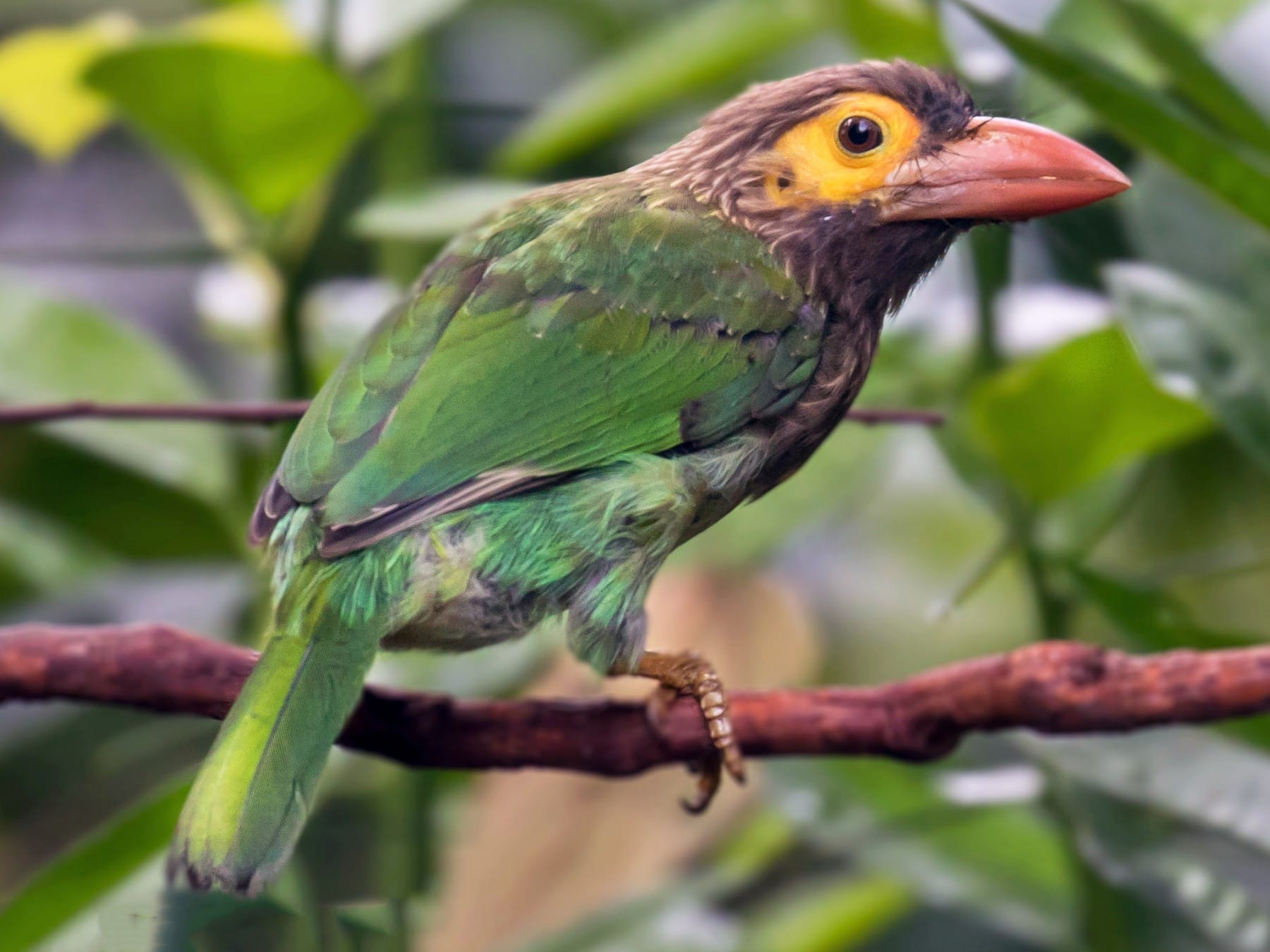
Their feathers provide insulation and protection from the elements, making their skin type avian. Although this bird species’ top speed is unknown, it is considered a slow flyer. The lifespan of the Large Green Barbet can range from 5 to 15 years, depending on various factors such as predation, disease, and environmental conditions. The average weight and length of this species are currently unknown. Overall, the Large Green Barbet is a fascinating bird species with unique characteristics and a striking appearance.
| Species Name | Large Green Barbet |
|---|---|
| Scientific Name | Megalaima zeylanica |
| Common Names | Large Green Barbet, Ceylon Barbet |
| Description | Renowned for vibrant appearance and distinct characteristics |
| Size | Large |
| Plumage | Stunning green |
| Diet | Fruits, insects, plant materials |
| Food Storage | Stores food in crops |
| Population Size | Unknown, believed to be stable |
| Threats | Deforestation, habitat loss |
| Habitat | Dense forests |
| Distinct Features | Vibrant green plumage, blends into lush vegetation |
| Wingspan | Approximately 30-35 cm |
| Incubation Period | Around 14-15 days |
| Distribution | Indian subcontinent, Southeast Asia |
| Nesting Behavior | Tree cavities |
| Molting Age | Unknown, possibly during the first year of life |
| Coloration | Green body with red patches on head and throat |
| Skin Type | Avian |
| Flight Speed | Unknown, considered a slow flyer |
| Lifespan | 5-15 years |
| Average Weight | Unknown |
| Average Length | Unknown |
Royal Tern
The Royal Tern, with its scientific name Thalasseus maximus, is a fascinating bird species. It preys on various fish in its habitat, such as small coastal and marine fish. A fun fact about the Royal Tern is that it often hovers above the water before diving headfirst to catch its prey. The estimated population size of this species is around 50,000 individuals. Its most significant threat is habitat loss and disturbance caused by human activities, such as coastal development.
The most distinctive feature of the Royal Tern is its bright orange bill and crest during the breeding season. Other names like King Tern and Maximilian Tern also know it. With a wingspan of around 3.5 feet, the Royal Tern can be found in coastal areas, including sandy beaches, estuaries, and lagoons. Its main predators include birds of prey, such as hawks and falcons, and larger predatory fish.
The diet of the Royal Tern mainly consists of fish, but it may also consume crustaceans and insects. This species belongs to the family Laridae and is commonly known as a seabird. There are around 45 species of terns in the world, with the Royal Tern being one of them. It can be found in various locations, including the Americas, Europe, Africa, and Asia coastal regions. The Royal Tern prefers to nest in colonies, often on sandy or rocky shores.
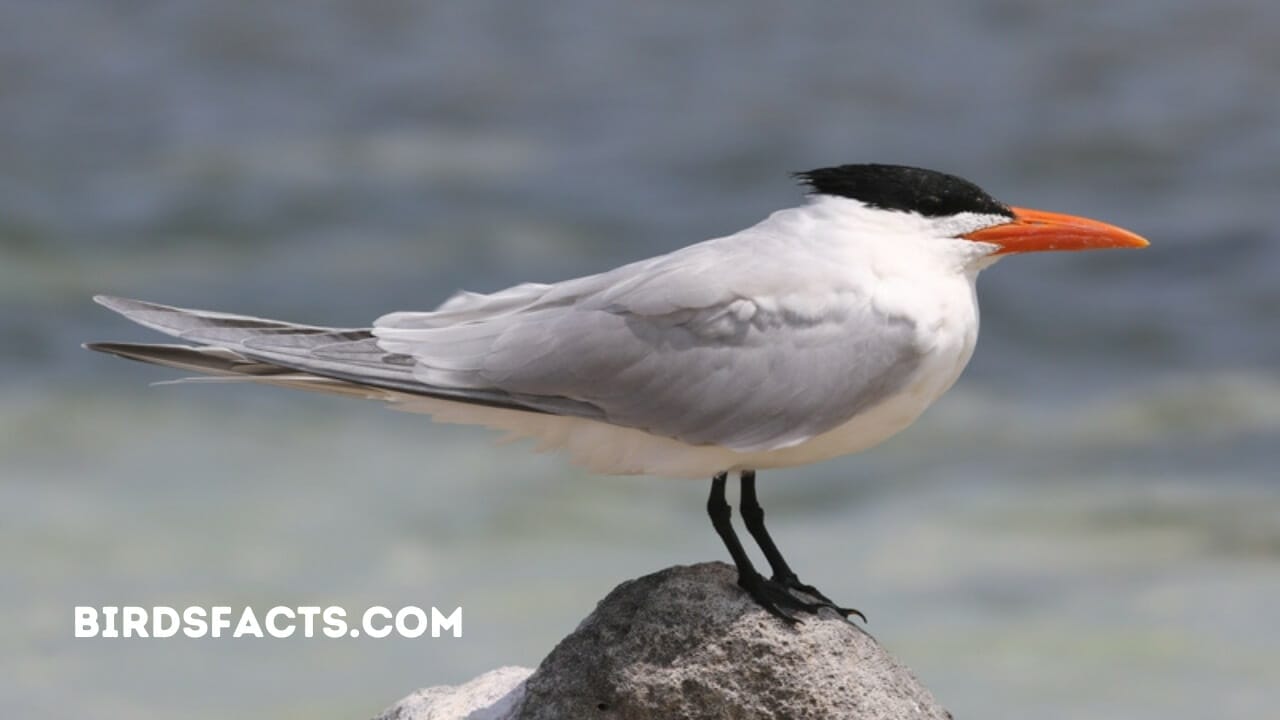
Molting in this species occurs at around two years of age. The Royal Tern has a black cap on its head, a white body, and a grey back and wings. It has webbed feet and feathers that are adapted for flying and swimming. Its top speed is estimated to be around 30 mph. The average lifespan of the Royal Tern is around 15 years. It weighs approximately 1 pound, and its length measures around 18-20 inches.
| Attribute | Information |
|---|---|
| Scientific name | Thalasseus maximus |
| Common names | Royal Tern, King Tern, Maximilian Tern |
| Habitat | Coastal areas, including sandy beaches, estuaries, and lagoons |
| Diet | Mainly fish, crustaceans, and insects |
| Prey | Small coastal and marine fish |
| Predators | Birds of prey (hawks and falcons), larger predatory fish |
| Breeding season features | Bright orange bill and crest |
| Wingspan | Approximately 3.5 feet |
| Population size | Around 50,000 individuals |
| Threats | Habitat loss and disturbance caused by human activities, such as coastal development |
| Family | Laridae |
| Seabird status | Yes |
| Tern species count | Approximately 45 species worldwide |
| Distribution | Americas, Europe, Africa, and Asia coastal regions |
| Nesting habits | Colony nesting on sandy or rocky shores |
| Molting | Occurs at around two years of age |
| Appearance | Black cap on head, white body, gray back and wings, webbed feet |
| Adaptations | Feathers adapted for flying and swimming |
| Top speed | Estimated around 30 mph |
| Lifespan | Approximately 15 years |
| Weight | Approximately 1 pound |
| Length | Around 18-20 inches |
Atlantic Puffin
The Atlantic Puffin, known by its scientific name Fratercula arctica, is a charismatic seabird in the Atlantic Ocean. Prey for the Atlantic Puffin consists mainly of small fish, such as herring and sand eels, which they catch by diving underwater. A fun fact about these birds is that they can fly up to 55 miles per hour, making them swift hunters in the sea. Although their population size is difficult to estimate, it is believed to be around 7 million individuals globally.
The biggest threat to Atlantic Puffins is habitat destruction and climate change, which affects their food sources. The most distinctive feature of these birds is their brightly colored beaks, which transform into bright orange in the breeding season. Atlantic Puffins are also known as sea parrots or clown birds due to their colorful appearance and behavior. With a wingspan of approximately 20 inches, these birds can be seen flying gracefully over the open ocean. Incubation for their eggs takes around 40 days, and their nesting location includes cliffs or burrows along coastal areas.
Predators of the Atlantic Puffin include gulls, raptors, and larger seabirds. Their diet mainly consists of small fish but may consume crustaceans and squid. Atlantic Puffins are a type of seabird and are one of three species of puffins found worldwide. They are most commonly found in the northern regions of the Atlantic Ocean, particularly in places like Iceland, Greenland, and the coasts of Europe and North America. These birds molt yearly, usually in late summer or early autumn.
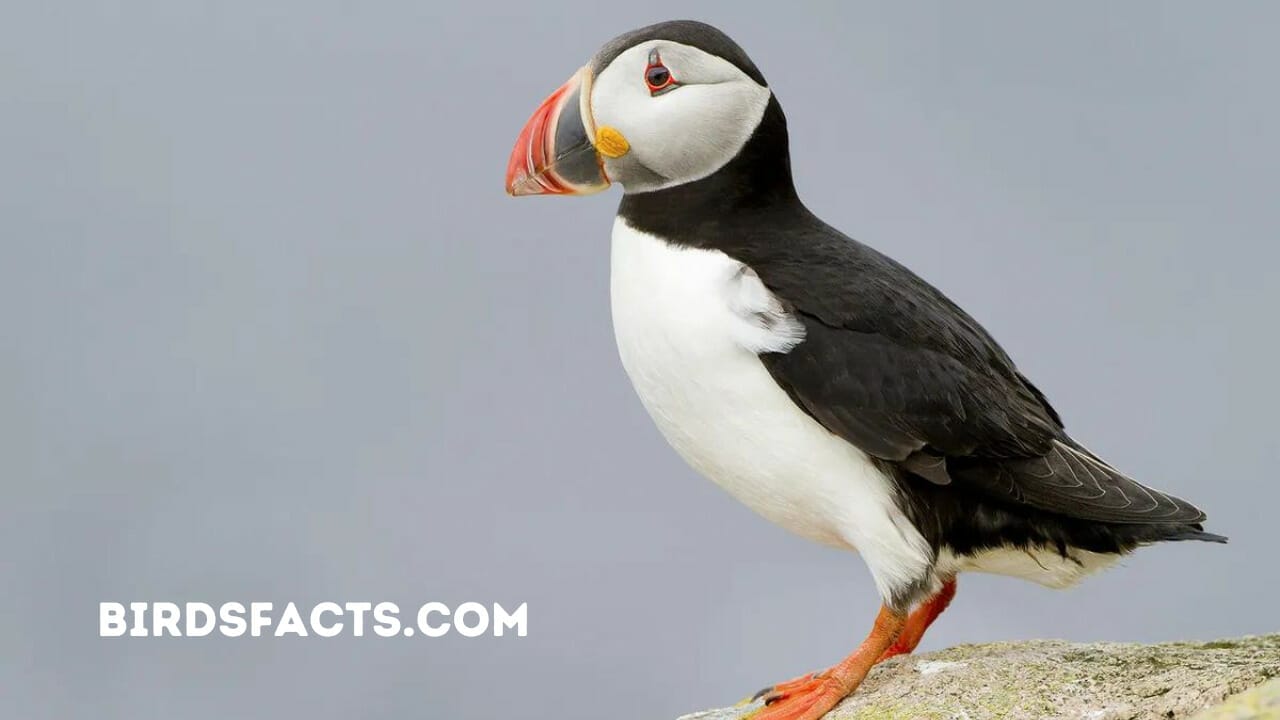
They have a colorful appearance, with black and white plumage on their body, grayish-blue skin on their face, and those distinctively bright beaks. Atlantic Puffins can live up to 20 years, with their weight ranging from 300 to 500 grams and their length measuring 11-13 inches. These charismatic seabirds leave a lasting impression with their distinctive features and fascinating behavior.
| Attribute | Description |
|---|---|
| Common Name | Atlantic Puffin |
| Scientific Name | Fratercula arctica |
| Habitat | Atlantic Ocean |
| Prey | Small fish (herring, sand eels), crustaceans, and squid |
| Hunting Method | Diving underwater |
| Maximum Speed | Up to 55 miles per hour |
| Estimated Global Population | Around 7 million individuals |
| Biggest Threats | Habitat destruction and climate change |
| Distinctive Feature | Brightly colored beaks that transform into bright orange in the breeding season |
| Nicknames | Sea parrots, clown birds |
| Wingspan | Approximately 20 inches |
| Incubation Period | Around 40 days |
| Nesting Location | Cliffs or burrows along coastal areas |
| Predators | Gulls, raptors, larger seabirds |
| Global Distribution | Northern regions of the Atlantic Ocean (Iceland, Greenland, coasts of Europe, and North America) |
| Molting Season | Late summer or early autumn |
| Lifespan | Up to 20 years |
| Weight Range | 300 to 500 grams |
| Length Range | 11-13 inches |
Toco Toucan
The Toco Toucan, known by its scientific name Ramphastos toco, is a striking bird native to South America. It is known for its large and colorful beak, measuring up to 7.5 inches long. This beak is the most distinctive feature of the Toco Toucan and is used for various purposes, including reaching fruit that other birds would not be able to access.
The Toco Toucan has a wingspan of approximately 46 inches and can fly at speeds of up to 20 miles per hour. It typically lives in the canopies of tropical rainforests, where it builds its nests in tree hollows, often high above the ground. The Toco Toucan feeds mainly on fruit but consumes insects, lizards, and small birds.
It is a social bird and can often be found in small flocks. The Toco Toucan has few natural predators due to its large size and intimidating beak. Still, it may occasionally fall prey to larger birds of prey, such as the Harpy Eagle. The Toco Toucan has an estimated population size of around 1.2 million individuals and is not currently considered endangered.
However, its most significant threat is the destruction of its habitat due to deforestation. The Toco Toucan has a lifespan of approximately 20 years in the wild and can weigh up to 1.5 pounds. It is primarily black with white markings on its beak and face. The Toco Toucan goes through a molting period at around 9 to 10 months of age, during which its feathers are replaced.
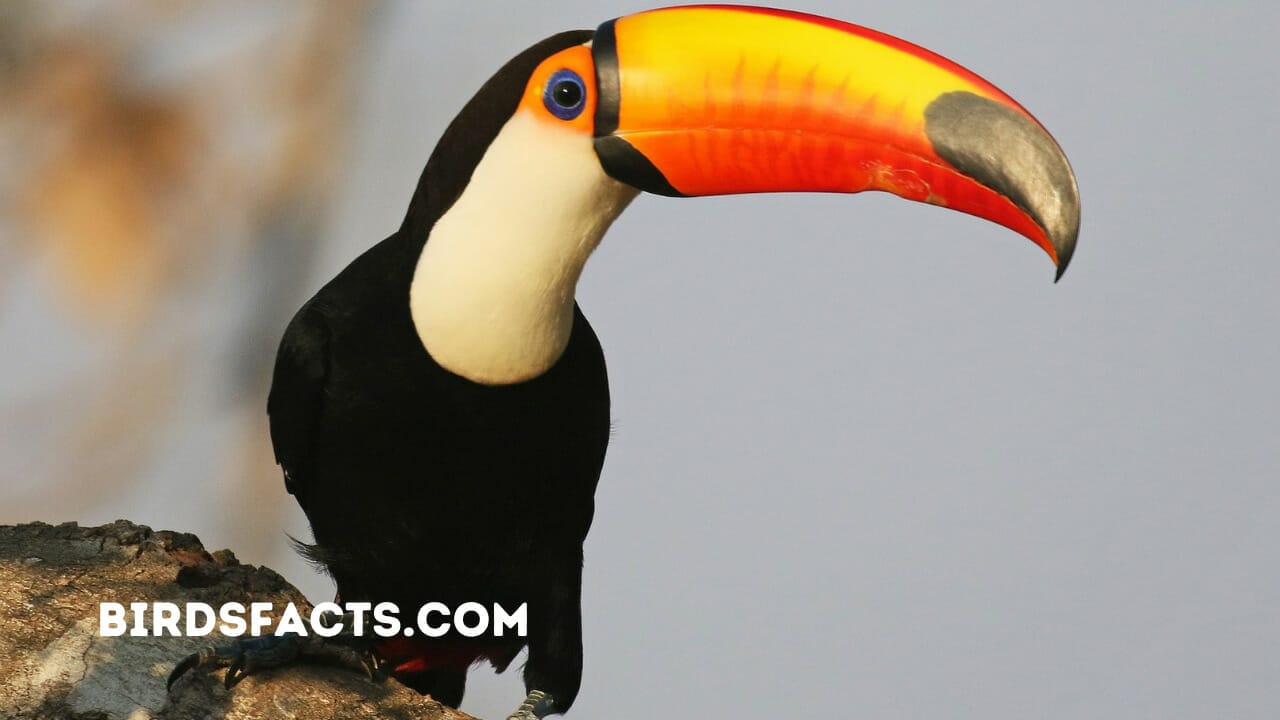
Overall, the Toco Toucan is a fascinating and visually striking bird that is an integral part of the ecosystem in South America.
| Attribute | Information |
|---|---|
| Scientific Name | Ramphastos toco |
| Common Name | Toco Toucan |
| Native to | South America |
| Description | Striking bird with large and colorful beak, measuring up to 7.5 inches long |
| Beak Function | Used for reaching fruit inaccessible to other birds |
| Wingspan | Approximately 46 inches |
| Flight Speed | Up to 20 miles per hour |
| Habitat | Canopies of tropical rainforests |
| Nesting Behavior | Builds nests in tree hollows, high above the ground |
| Diet | Mainly fruit, also insects, lizards, and small birds |
| Social Behavior | Often found in small flocks |
| Predators | Few natural predators, but vulnerable to larger birds of prey |
| Population Size | Approximately 1.2 million individuals |
| Conservation Status | Not currently considered endangered |
| Threats | Habitat destruction due to deforestation |
| Lifespan | Approximately 20 years in the wild |
| Weight | Up to 1.5 pounds |
| Appearance | Primarily black with white markings on beak and face |
| Molting | Molts feathers at around 9-10 months of age |
| Role in Ecosystem | Integral part of the ecosystem in South America |
Greylag Goose
The Greylag Goose, scientifically known as Anser anser, is a species of waterfowl that belongs to the Anatidae family. It is a medium-sized bird that primarily feeds on vegetation such as grasses, sedges, and crops. The Greylag Goose is fascinating in many ways, including its estimated population size of around 670,000 individuals.
However, despite its large population, the biggest threat to this species is habitat loss due to urbanization and agricultural development. The most distinctive feature of the Greylag Goose is its dark grey plumage, which is complemented by a white blaze around its bill.
This goose is also known by other names such as gray goose or graylag goose. With a wingspan of approximately 1.6 meters, the Greylag Goose can fly long distances during its annual migration. Regarding nesting, these geese prefer locations near water bodies, such as lakes, rivers, or marshes. As for predators, the Greylag Goose’s eggs and young are vulnerable to various mammalian species, including foxes and raccoons. Regarding diet, these birds are primarily herbivorous, grazing on grasses and other plant material.
They are classified as wild waterfowl and are commonly found in Europe and Asia. The Greylag Goose molts its feathers yearly, usually in the early summer. The coloration of this goose is predominantly grey with lighter underparts. Its skin type is covered with feathers and has a top speed of roughly 46 miles per hour.
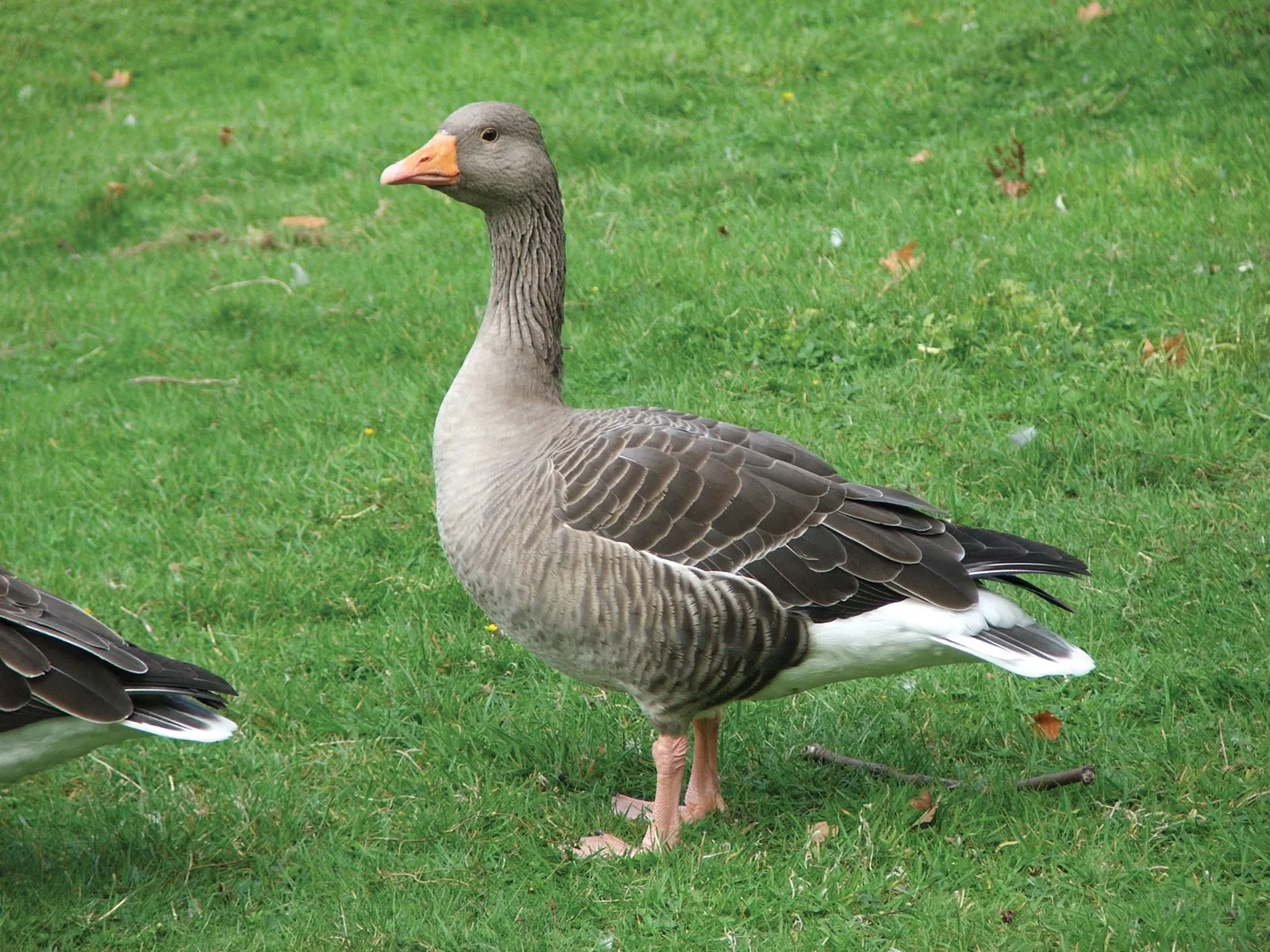
The lifespan of a Greylag Goose can range from 10 to 20 years, with adults typically weighing between 3.3 and 6.2 kilograms. In terms of length, these geese measure approximately 74 to 89 centimeters, making them a medium-sized bird. The Greylag Goose is an intriguing species with unique characteristics and behaviors.
| Attribute | Information |
|---|---|
| Scientific Name | Anser anser |
| Family | Anatidae |
| Size | Medium-sized |
| Feeding Habits | Primarily vegetation such as grasses, sedges, and crops |
| Population Size | Approximately 670,000 individuals |
| Threats | Habitat loss due to urbanization and agricultural development |
| Plumage | Dark grey with a white blaze around the bill |
| Other Names | Gray goose, graylag goose |
| Wingspan | Approximately 1.6 meters |
| Nesting | Near water bodies such as lakes, rivers, or marshes |
| Predators | Eggs and young vulnerable to various mammalian species including foxes and raccoons |
| Diet | Primarily herbivorous, grazing on grasses and other plant material |
| Habitat | Commonly found in Europe and Asia |
| Molting | Yearly, usually in early summer |
| Coloration | Predominantly grey with lighter underparts |
| Skin Type | Covered with feathers |
| Top Speed | Approximately 46 miles per hour |
| Lifespan | Range from 10 to 20 years |
| Weight (Adults) | 3.3 to 6.2 kilograms |
| Length | Approximately 74 to 89 centimeters |
Mute Swan
The Mute Swan, the scientific name Cygnus olor, is a majestic bird known for its graceful appearance and serene nature. This beautiful creature is found throughout Europe, Asia, and North Africa. It is a relatively large bird with a wingspan that can reach up to 2.4 meters and a length ranging from 1.5 to 1.8 meters. Mute Swans are most commonly found in wetland habitats such as lakes, ponds, and marshes.
They primarily feed on aquatic plants and consume insects, small fish, and frogs. Mute Swans are known for their distinctive feature of having a bright white plumage, which contrasts sharply with their black legs and orange bill. Despite their name, Mute Swans are not mute but produce a range of vocalizations, including hissing and trumpeting. The male swan, known as a cob, is usually larger and heavier, with a weight exceeding 12 kilograms, while the female, or pen, is slightly smaller, weighing around 9 kilograms. Mute Swans have an average lifespan of about 20 years but can live up to 30 years in captivity.
Their populations are estimated to be around 500,000 individuals globally. However, their numbers have declined due to various threats, including habitat loss, pollution, and hunting. The Mute Swan is not known to have any natural predators, as its size and aggressive behavior toward potential threats usually keep them at bay. During the breeding season, Mute Swans build large nests made from vegetation near the water’s edge, where the female will lay a clutch of 4-8 eggs.
These eggs are incubated for about 35 days until they hatch, with both parents responsible for guarding the nest. Mute Swans go through a molting process at around two years of age, where they shed their flight feathers and cannot fly for several weeks. This molting period typically occurs during the summer months when their natural habitat is lush, and food is abundant.
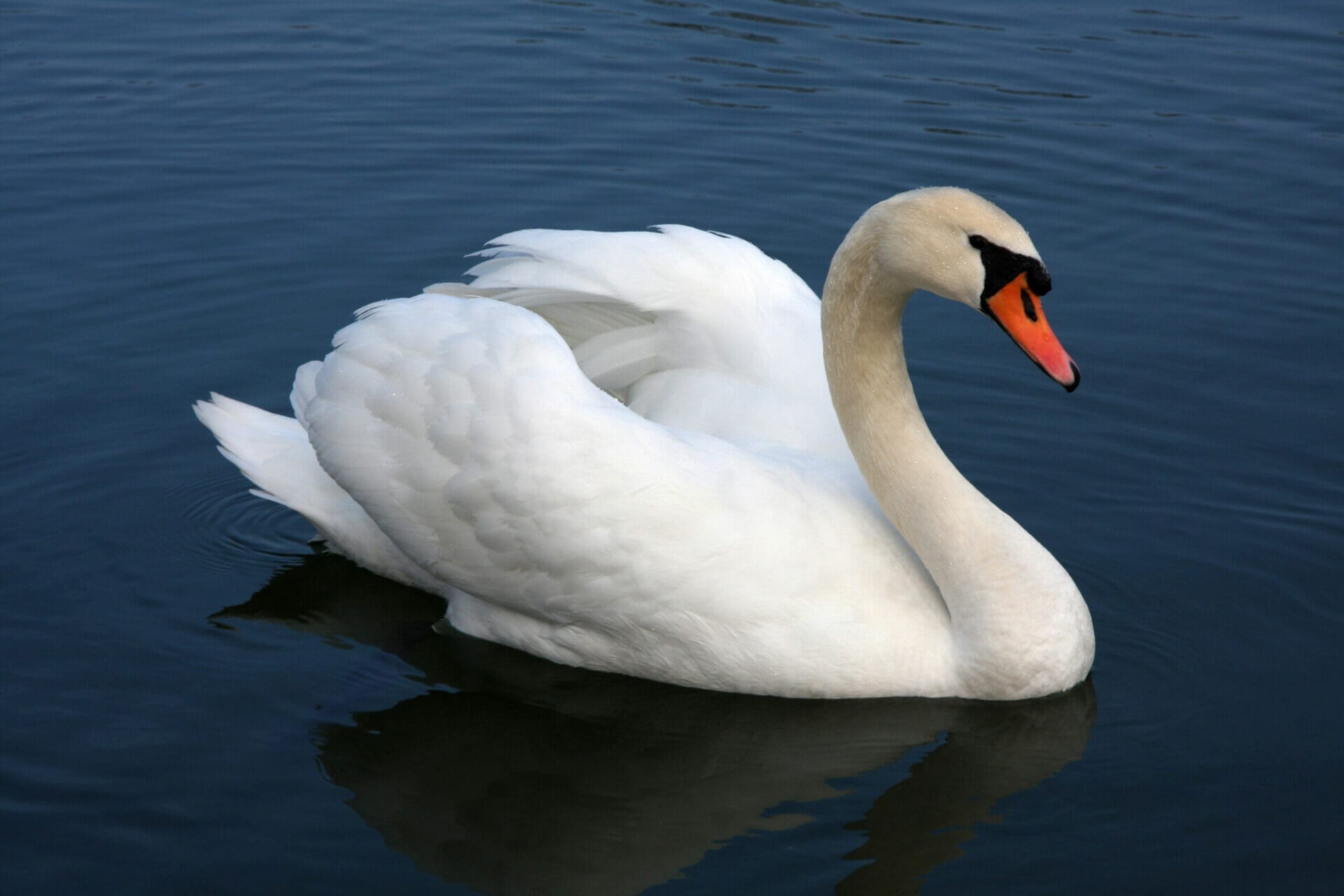
Overall, Mute Swans are genuinely captivating creatures with their elegant presence and striking appearance, making them a unique species in the avian world.
| Species Name | Mute Swan |
|---|---|
| Scientific Name | Cygnus olor |
| Description | Majestic bird known for graceful appearance and serene nature |
| Distribution | Europe, Asia, and North Africa |
| Size | Wingspan: Up to 2.4 meters |
| Length: 1.5 to 1.8 meters | |
| Habitat | Wetland habitats including lakes, ponds, and marshes |
| Diet | Aquatic plants, insects, small fish, and frogs |
| Plumage | Bright white with black legs and orange bill |
| Vocalizations | Hissing, trumpeting, and various vocalizations |
| Male | Known as cob, larger and heavier |
| Weight: Exceeding 12 kilograms | |
| Female | Known as pen, slightly smaller |
| Weight: Around 9 kilograms | |
| Lifespan | Average: About 20 years |
| Maximum: Up to 30 years in captivity | |
| Population | Estimated around 500,000 individuals globally |
| Threats | Habitat loss, pollution, and hunting |
| Predators | Not known to have natural predators |
| Breeding | Nest building near water’s edge, clutch size: 4-8 eggs |
| Incubation | Approximately 35 days |
| Molting | Occurs at around two years of age |
| Shed flight feathers and cannot fly for weeks | |
| Captivating | Elegant presence and striking appearance |
Crested Auklet
The Crested Auklet, scientifically known as Aethia cristatella, is a seabird species in the northern Pacific Ocean. These birds feed on small fish and zooplankton, using their sharp beaks to catch their prey. One interesting fact about Crested Auklets is that they have a unique crest on their head during the breeding season, which gives them their name.
This crest comprises small feathers that stick up, giving them a distinctive appearance. The estimated population size of Crested Auklets is around 3 million individuals. Their biggest threat is climate change, causing changes in their ocean habitat and food availability.
The most distinctive feature of Crested Auklets is their crest, which is only present during the breeding season. This crest is used for courtship displays and to attract mates. Crested Auklets are also known by their other name, the “tufted puffin.”
Crested Auklets have a wingspan of approximately 11-14 inches and an incubation period of 24-26 days. They inhabit offshore waters and breed on rocky islands and cliffs. Some of their predators include larger seabirds and mammals, such as gulls and sea otters.
The diet of Crested Auklets consists mainly of small fish and zooplankton. They are diving birds, diving into the water to catch their prey. They are considered to be “Least Concern” regarding conservation status.
Crested Auklets are known for their black and white plumage. Their skin type is covered in feathers. They have a top speed of around 47 miles per hour and a lifespan of approximately 16 years. They weigh around 10 ounces and are about 7-9 inches long.

Overall, the Crested Auklet is a unique and fascinating seabird found in the northern Pacific Ocean. Despite the challenges they face due to climate change, they continue to be an essential species in the marine ecosystem.
| Species Name | Crested Auklet |
|---|---|
| Scientific Name | Aethia cristatella |
| Habitat | Northern Pacific Ocean |
| Feeding Habits | Small fish and zooplankton |
| Special Feature | Crest on head during breeding season |
| Population Size | Approximately 3 million individuals |
| Threats | Climate change |
| Wingspan | Approximately 11-14 inches |
| Incubation Period | 24-26 days |
| Breeding Habitat | Rocky islands and cliffs |
| Predators | Larger seabirds, gulls, sea otters |
| Conservation Status | Least Concern |
| Plumage Color | Black and white |
| Skin Type | Covered in feathers |
| Top Speed | Approximately 47 miles per hour |
| Lifespan | Approximately 16 years |
| Weight | Around 10 ounces |
| Length | Approximately 7-9 inches |
Rainbow Lorikeet
The Rainbow Lorikeet, scientifically known as Trichoglossus moluccanus, is a vibrant and colorful bird that belongs to the parrot family. These beautiful birds are native to Australia, specifically the eastern coast and parts of Indonesia. They can be found in various habitats, from rainforests to urban gardens. Rainbow Lorikeets are known for their distinctive feature of bright and colorful feathers with a combination of red, blue, green, and yellow hues. 3
They have a wingspan of around 17 to 20 inches and can reach up to 35 miles per hour. These birds have a diet mainly consisting of nectar, pollen, fruits, and occasionally insects. Their specialized brush-like tongue allows them to extract nectar from flowers efficiently.
Rainbow Lorikeets are social creatures and can often be found in large flocks. They are playful and energetic, engaging in acrobatic flights and entertaining displays. Their estimated population size is abundant, with no concerns of endangerment. However, their biggest threat is habitat loss due to deforestation and urbanization.
These birds are known by other names, such as the Red-collared Lorikeet or the Swainson’s Lorikeet. They have a lifespan of around 20 years in captivity and can weigh up to 160 grams.
Rainbow Lorikeets are medium-sized parrots, typically measuring around 10 to 12 inches in length. They molt at the age of approximately one year, and their vibrant colors continue to develop as they age.
Regarding predators, Rainbow Lorikeets must watch out for larger birds, such as hawks and owls. For nesting, they prefer tree hollows or crevices in rocks, where they lay one to two eggs at a time. The incubation period typically lasts around 24 days, after which the chicks hatch.

Overall, Rainbow Lorikeets are stunning creatures that bring vibrant colors and cheerful melodies to their habitats, making them a delight to observe and admire.
| Feature | Description |
|---|---|
| Scientific Name | Trichoglossus moluccanus |
| Common Names | Rainbow Lorikeet, Red-collared Lorikeet, Swainson’s Lorikeet |
| Family | Parrot |
| Native Region | Australia (eastern coast) and parts of Indonesia |
| Habitat | Rainforests, urban gardens, and various habitats |
| Size | Medium-sized, approximately 10 to 12 inches in length |
| Wingspan | Around 17 to 20 inches |
| Speed | Up to 35 miles per hour |
| Colors | Bright and colorful feathers with a combination of red, blue, green, and yellow hues |
| Diet | Nectar, pollen, fruits, and occasionally insects |
| Tongue | Specialized brush-like tongue for efficient extraction of nectar from flowers |
| Social Behavior | Social creatures, often found in large flocks |
| Population Status | Abundant with no concerns of endangerment |
| Threats | Habitat loss due to deforestation and urbanization |
| Lifespan | Around 20 years in captivity |
| Weight | Up to 160 grams |
| Molting | Occurs at approximately one year old, vibrant colors develop as they age |
| Predators | Larger birds such as hawks and owls |
| Nesting | Tree hollows or crevices in rocks, laying one to two eggs at a time |
| Incubation Period | Around 24 days |
Cattle Egret
The Cattle Egret, scientifically known as Bubulcus ibis, is a species of egret found in various regions worldwide. One of the exciting aspects of this bird is its diet. The Cattle Egret primarily preys on insects and sometimes small vertebrates. They have an unusual feeding behavior of foraging alongside cattle to catch the insects stirred up by them.
This behavior has earned them the nickname “Cowbird.” Despite their opportunistic feeding habits, the Cattle Egret is not picky and will feed on other prey. With an estimated population size in the millions, the Cattle Egret is considered a species of most minor concern regarding conservation status.
However, the biggest threat to their population is habitat loss due to human activities.
One of the most distinctive features of the Cattle Egret is its white plumage, which contrasts against its bright yellow bill and yellow legs. This coloration makes it easily recognizable in the field. Additionally, the Cattle Egret has a wingspan that can reach 90-96 cm and is well adapted for flight.
They are known to nest in colonies in trees, near water bodies, or in dense vegetation. These colonies can range from a few nesting pairs to hundreds of couples. As for their predators, the Cattle Egret faces threats from larger birds such as raptors and owls. The Cattle Egret has a lifespan of around 10-12 years in the wild, and they usually molt for the first time when they are about one year old.
The Cattle Egret can be found in various habitats, including wetlands, grasslands, and pastures. They are highly adaptable and can also be seen in urban environments. In terms of size, they weigh around 350-530g and have a length of approximately 45-56 cm.
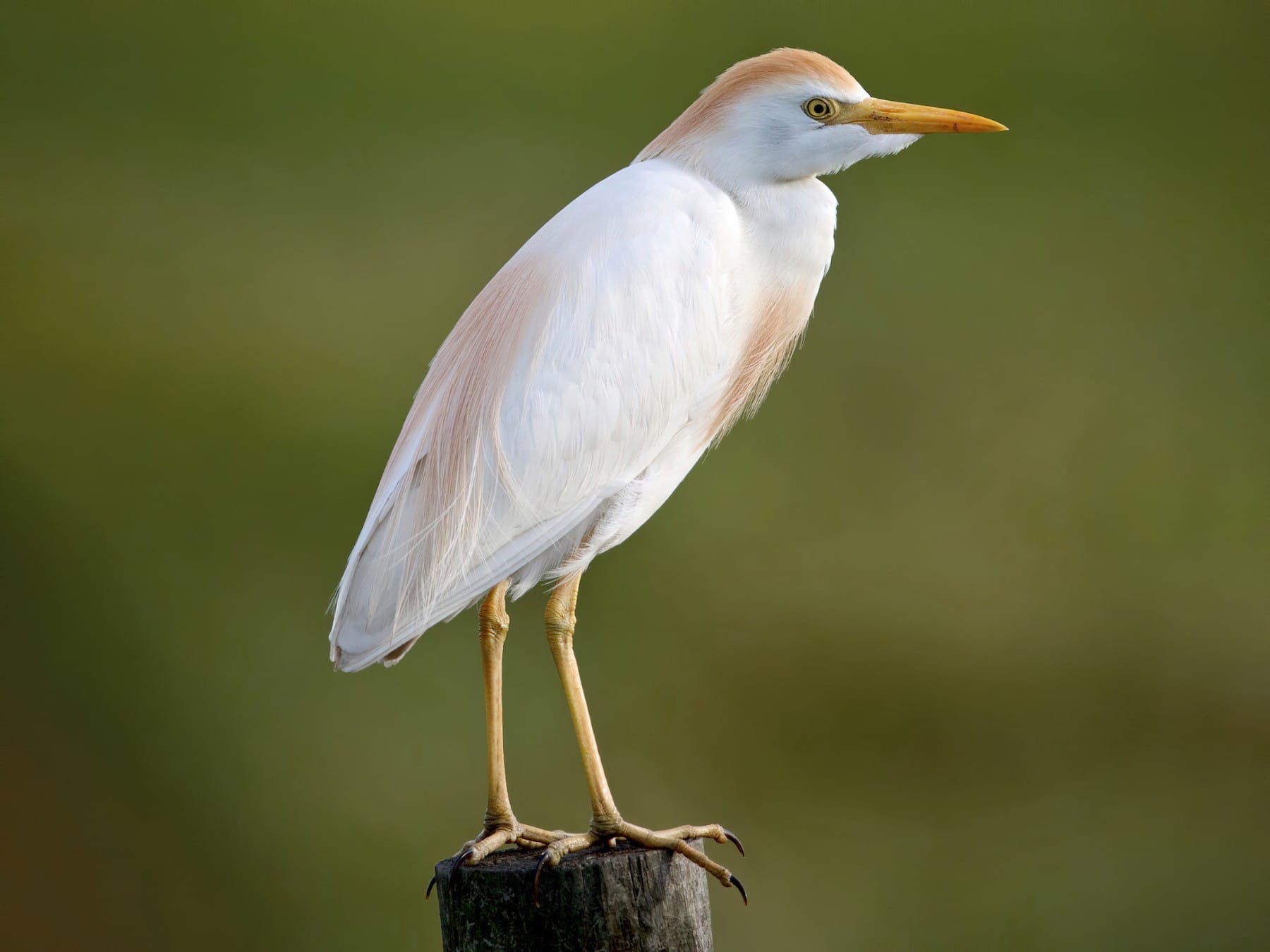
Overall, the Cattle Egret is a fascinating bird that benefits from its association with cattle and plays an important ecological role by controlling insect populations.
| Aspect | Information |
|---|---|
| Scientific Name | Bubulcus ibis |
| Common Name | Cattle Egret |
| Distribution | Various regions worldwide |
| Diet | Insects, small vertebrates |
| Feeding Behavior | Forages alongside cattle to catch insects stirred up by them |
| Nickname | Cowbird |
| Conservation Status | Species of least concern |
| Population Threats | Habitat loss due to human activities |
| Plumage | White with bright yellow bill and yellow legs |
| Wingspan | 90-96 cm |
| Nesting Behavior | Colonies in trees, near water bodies, or dense vegetation |
| Predators | Larger birds such as raptors and owls |
| Lifespan | 10-12 years in the wild |
| First Molting Age | Around one year old |
| Habitat | Wetlands, grasslands, pastures, and urban environments |
| Weight | 350-530g |
| Length | 45-56 cm |
| Ecological Role | Controls insect populations |
American White Pelican
The American White Pelican, scientifically known as Pelecanus erythrorhynchos, is a large water bird found primarily in North America. It is known for its distinctive white plumage, long bill, and large size. The American White Pelican is a formidable predator, feeding mainly on fish.
It uses a unique feeding technique: it floats on the water’s surface and dips its head below to scoop up fish in its pouch-like bill. This species is estimated to have a population size of around 65,000 individuals. The biggest threat to their population is habitat loss and disturbance during nesting periods.
American White Pelicans have a wingspan of up to 9 feet, making them one of the largest bird species in North America. They nest in large colonies on islands or isolated areas in freshwater lakes and marshes. While they have few natural predators, they are sometimes preyed upon by Bald Eagles and Great Horned Owls. In addition to fish, they also consume amphibians, crustaceans, and small birds. American White Pelicans are classified as water birds typically found in aquatic habitats such as lakes, rivers, and estuaries.
They are predominantly white with black flight feathers and a bright orange bill. Their skin is waterproof and covered in feathers. Although they are not known for their speed, they can reach top speeds of up to 30 miles per hour in flight. The average lifespan of an American White Pelican is around 10 to 16 years in the wild. They can weigh between 11 to 20 pounds and have a length of about 50 to 70 inches.
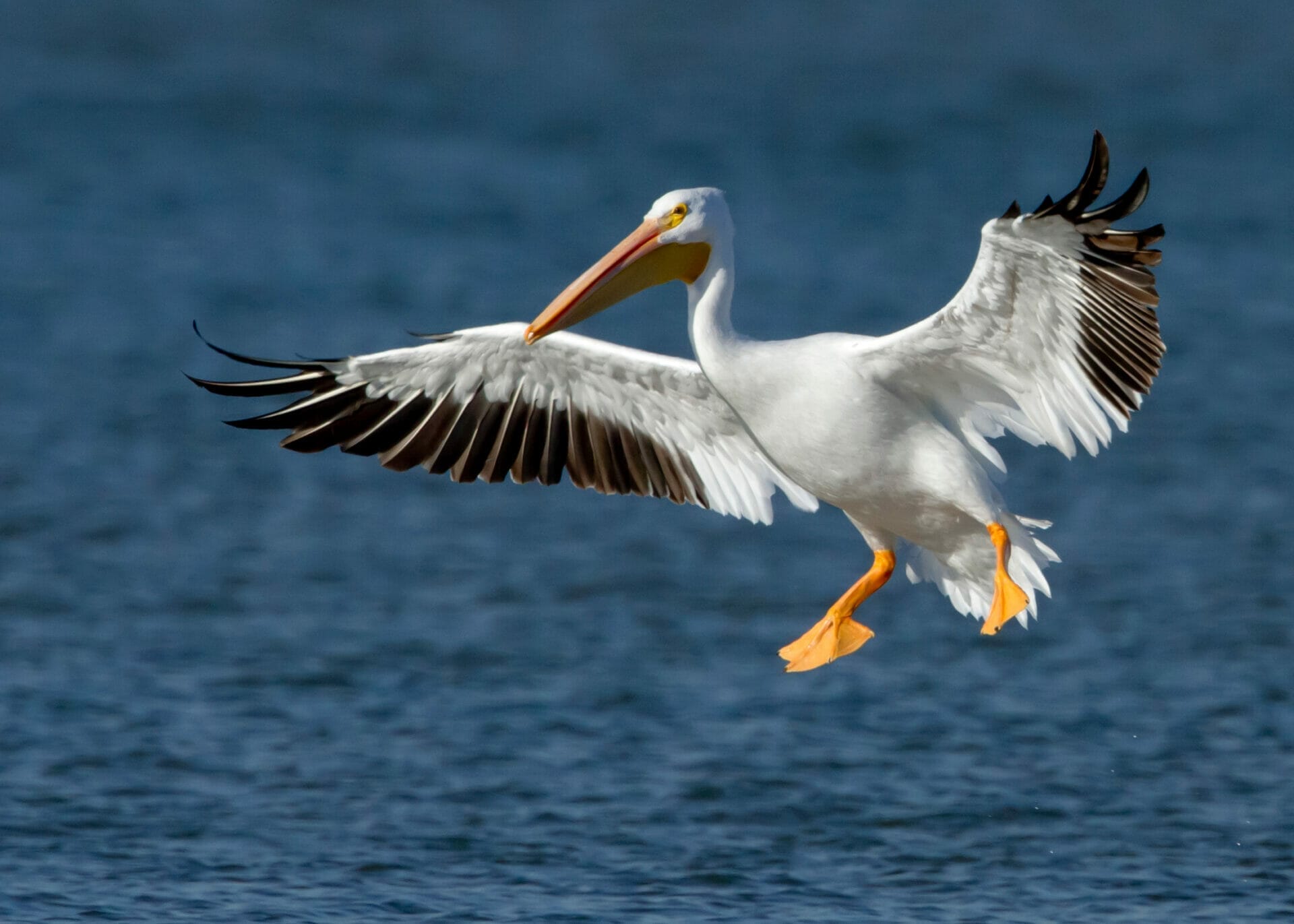
The American White Pelican is a fascinating bird species known for its large size, unique feeding behavior, and beautiful plumage.
| Information | Value |
|---|---|
| Scientific Name | Pelecanus erythrorhynchos |
| Common Name | American White Pelican |
| Habitat | North America |
| Description | Large water bird with white plumage |
| Unique Features | Long bill and large size |
| Feeding Behavior | Floats on water’s surface, scoops fish in bill |
| Population Estimate | Approximately 65,000 individuals |
| Major Threats | Habitat loss and disturbance during nesting |
| Wingspan | Up to 9 feet |
| Nesting Habits | Large colonies on islands or isolated areas |
| Natural Predators | Bald Eagles and Great Horned Owls |
| Diet | Fish, amphibians, crustaceans, small birds |
| Habitat Classification | Water birds in lakes, rivers, and estuaries |
| Plumage Colors | Predominantly white with black flight feathers |
| Bill Color | Bright orange |
| Skin Characteristics | Waterproof and covered in feathers |
| Flight Speed | Up to 30 miles per hour |
| Lifespan (Wild) | 10 to 16 years |
| Weight | 11 to 20 pounds |
| Length | Approximately 50 to 70 inches |
| Notable Traits | Large size, unique feeding behavior, beautiful plumage |
White Throated Kingfisher
The White Throated Kingfisher, scientifically known as Halcyon smyrnensis, is a magnificent bird found in various parts of Asia. It is well-known for its striking appearance and distinctive features. This kingfisher has a robust build with a wingspan of approximately 25-29 centimeters and a length of around 27-30 centimeters. Its most notable feature is its vibrant blue plumage covering most of its body, while its throat is white. As the common name suggests, the white throat of the bird is quite prominent and adds to its overall charm.
These beautiful birds are predominantly found near water bodies, such as lakes, rivers, and ponds, where they build their nests. They have a wide range of diets, primarily hunting fish, crustaceans, and insects. Their hunting involves perching on a branch or wire and swooping swiftly to catch their prey. Their top speed is estimated to be around 40-50 kilometers per hour, making them excellent hunters.
The estimated population size of the White Throated Kingfisher is challenging to determine accurately as it is widely spread across the Asian continent. However, they are not considered endangered and are in a stable population.
One interesting fact about these kingfishers is that they are known to avoid areas with heavy pollution or disturbance. Therefore, their presence in a room can indicate their ecological health.
Their nests are built in natural cavities like tree holes or termite mounds. They also lay their eggs in these cozy nests and incubate them for about 19-20 days until they hatch. The chicks stay in the nests for another 28-30 days before venturing independently.
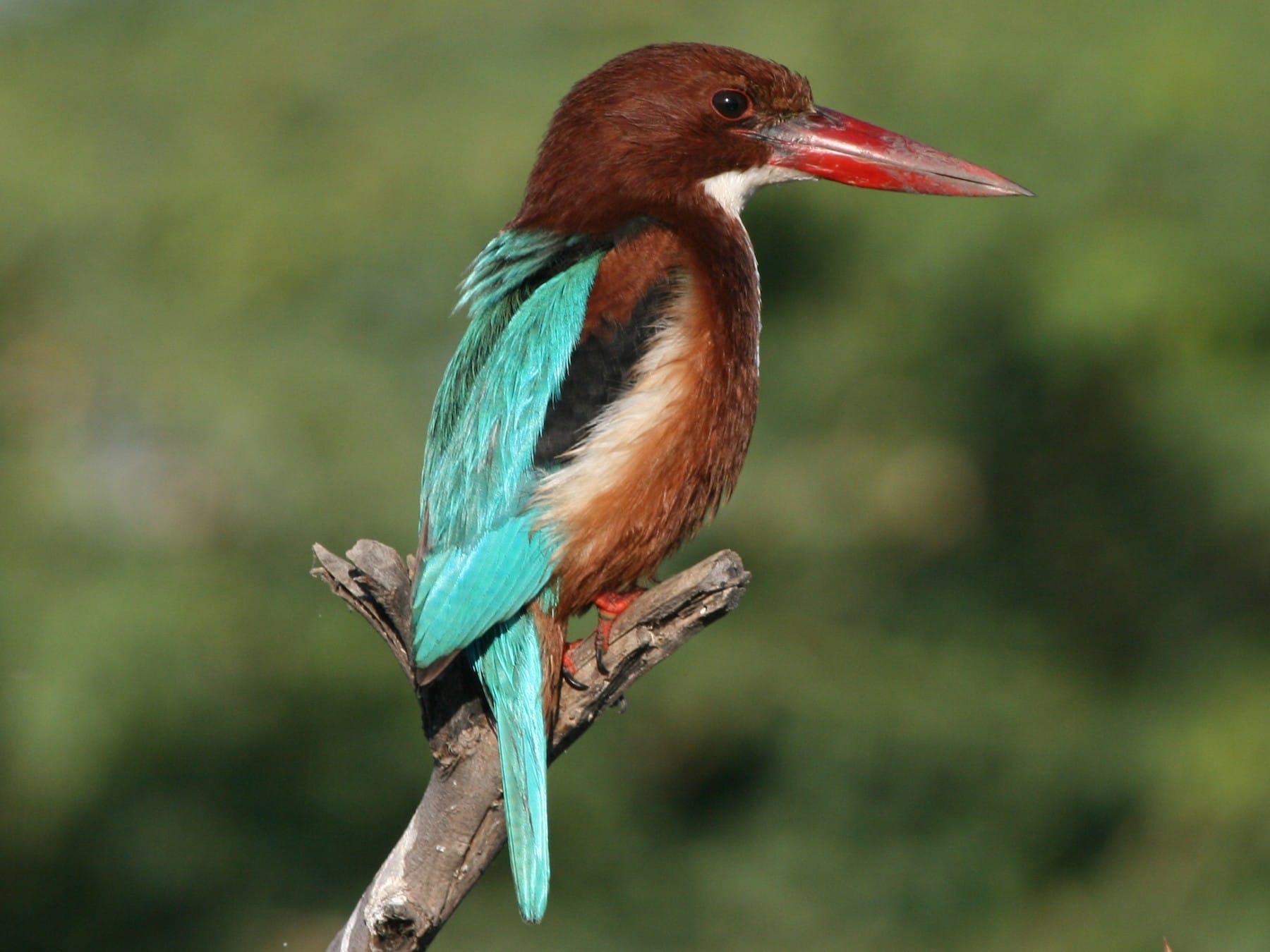
The White Throated Kingfisher faces various threats, including habitat loss and degradation due to human activities. The destruction of their nesting locations and fragmentation of their habitats affect their population. Additionally, the use of pesticides in agricultural practices can also impact their food sources and overall health. Conservation efforts must be in place to ensure the survival and well-being of these beautiful birds.
| Species Name | Halcyon smyrnensis |
|---|---|
| Common Name | White Throated Kingfisher |
| Scientific Name | Halcyon smyrnensis |
| Description | Magnificent bird found in Asia |
| Appearance | Robust build, vibrant blue plumage with white throat |
| Wingspan | Approximately 25-29 centimeters |
| Length | Around 27-30 centimeters |
| Habitat | Near water bodies, lakes, rivers, ponds |
| Diet | Fish, crustaceans, insects |
| Hunting Technique | Perching and swooping swiftly |
| Top Speed | Estimated 40-50 kilometers per hour |
| Population Status | Stable population, not endangered |
| Indicator of Ecological Health | Avoids areas with heavy pollution or disturbance |
| Nesting Locations | Natural cavities, tree holes, termite mounds |
| Incubation Period | 19-20 days |
| Nestling Period | 28-30 days |
| Threats | Habitat loss, degradation, fragmentation, pesticide use |
| Conservation Efforts | Necessary to ensure survival and well-being of the species |
American Oystercatcher
The American Oystercatcher, scientifically known as Haematopus palliatus, is a distinctive bird found along the coasts of North and South America. This species preys on shellfish, using its long, orange bill to pry open shells and extract the meat inside. They are known to dine on clams, mussels, and oysters, hence their common name. Interestingly, the American Oystercatcher plays an essential role in maintaining the health of coastal ecosystems by controlling the populations of these prey species.
The estimated population size of the American Oystercatcher is approximately 11,000 individuals. Their biggest threat is losing and degrading their coastal habitats due to human activities such as coastal development and pollution. One of the most distinctive features of this bird is its vibrant orange bill, which contrasts sharply with its black body and white underparts. They are also known for their loud, distinctive call, often heard along the shorelines.
Other names, such as the American Pied Oystercatcher and the American Beach Oystercatcher, are also known as the American Oystercatcher. These birds are skilled flyers with a wingspan around 30 to 38 inches. They typically nest in open areas on sandy or rocky beaches, creating shallow scrapes in the sand or gravel for their eggs.
Predators of the American Oystercatcher include large gulls, crows, and raccoons, who often raid their nests for eggs and chicks. In terms of diet, these birds primarily consume shellfish but may also feed on small crabs and marine worms. They are classified as waders, meaning they are birds that forage in shallow water or along shorelines.
The American Oystercatcher has a lifespan of around 15 to 20 years in the wild. They are medium-sized birds weighing approximately 1.5 to 2 pounds and measuring about 17 to 21 inches in length. They have black upperparts, a white belly, and vibrant orange legs. Their plumage is waterproof, covering their skin with feathers that repel water.

While their top speed needs to be better documented, American Oystercatchers fly swiftly and maneuver well to evade predators or catch prey. They typically undergo molting after their first breeding season and throughout their adult lives. This molting process involves shedding and replacing old feathers, ensuring their plumage remains in good condition. As coastal dwellers, these birds rely on a healthy coastal environment, making it essential for humans to protect and conserve their habitats.
| Species Name | American Oystercatcher |
|---|---|
| Scientific Name | Haematopus palliatus |
| Description | Distinctive bird found along North and South American coasts. Preys on shellfish using long, orange bill. Plays a role in maintaining coastal ecosystem health. |
| Population Size | Approximately 11,000 individuals |
| Threats | Coastal habitat loss and degradation due to human activities such as coastal development and pollution |
| Physical Characteristics | Black body, white underparts, vibrant orange bill, orange legs, medium-sized (1.5 to 2 pounds), length of about 17 to 21 inches |
| Names | American Pied Oystercatcher, American Beach Oystercatcher |
| Wingspan | Around 30 to 38 inches |
| Nesting | Sandy or rocky beaches, shallow scrapes in sand or gravel for eggs |
| Predators | Large gulls, crows, raccoons |
| Diet | Primarily shellfish, small crabs, marine worms |
| Lifespan | Approximately 15 to 20 years in the wild |
| Flying Abilities | Swift flight, good maneuverability |
| Molting | Shedding and replacing old feathers |
| Habitat Dependence | Relies on a healthy coastal environment |
Common Blackbird
The Common Blackbird, scientifically known as Turdus merula, is commonly found across Europe and Asia. With a population size estimated to be in the hundreds of millions, the Common Blackbird is one of the most widespread bird species in the world. Its most distinctive feature is its striking black plumage, accentuated by a bright yellow eye ring.
The bird has a wingspan of about 33-38 centimeters, and both males and females contribute to incubating the eggs during the nesting period. Common Blackbirds are omnivorous, feeding on a varied diet that includes insects, earthworms, fruits, and berries. They are also known to forage on the ground, using their beaks to dig for food. These birds are typically found in various habitats, including woodlands, gardens, and parks.
While the Common Blackbird does have predators, such as birds of prey and domestic cats, its population remains stable due to its adaptability and ability to thrive in urban environments. The average lifespan of a Common Blackbird is around 5 years. These birds molt once a year, usually during late summer or early autumn, when they shed old feathers and grow new ones. The Common Blackbird is a medium-sized bird weighing around 80-115 grams and measuring about 24-29 centimeters in length.
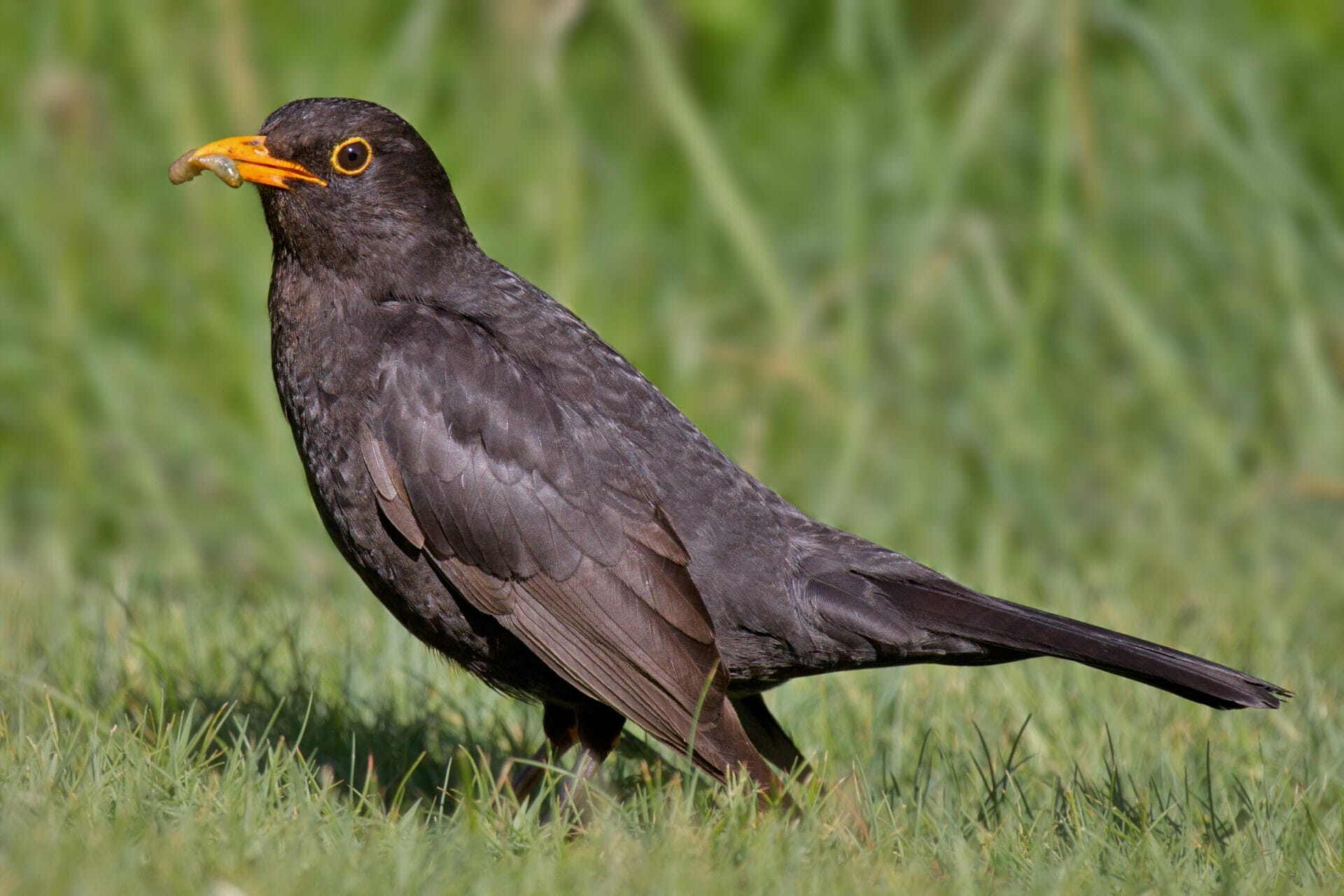
Overall, the Common Blackbird is a resilient and adaptable species, with its distinctive black plumage and melodious song making it a common sight in many parts of the world.
| Species Name | Common Blackbird |
|---|---|
| Scientific Name | Turdus merula |
| Distribution | Europe and Asia |
| Population Size | Hundreds of millions |
| Wingspan | Approximately 33-38 centimeters |
| Plumage Color | Striking black |
| Eye Ring Color | Bright yellow |
| Nesting Behavior | Both males and females contribute to incubating the eggs |
| Diet | Insects, earthworms, fruits, berries |
| Foraging Behavior | Ground forager, uses beak to dig for food |
| Habitat | Woodlands, gardens, parks |
| Predators | Birds of prey, domestic cats |
| Adaptability | Thrives in urban environments |
| Lifespan | Around 5 years |
| Molting Frequency | Once a year, usually late summer or early autumn |
| Weight | Approximately 80-115 grams |
| Length | Approximately 24-29 centimeters |
| Resilience | Resilient and adaptable species |
| Melodious Song | Commonly heard in many parts of the world |
Inca Tern
The Inca Tern, scientifically known as Larosterna Inca, is a unique bird found along the Pacific coast of South America, from Peru to Chile. The Inca Tern is easily recognizable with its stunning black and white plumage adorned with a bright red beak and feet. One of its most distinctive features is its long, white mustache-like feather tufts that extend from the sides of its head. Inca Terns have a wingspan of approximately 28 inches and can weigh between 300-400 grams. They have a lifespan of about 12-15 years.
These elegant birds feed on small fish and squid, which they catch by diving into the ocean from above. They are skilled hunters, capable of detecting multiple prey in a single dive. The Inca Tern is known for its unique mating rituals, where males display their brightly colored beaks and engage in elaborate courtship dances to attract females.
The estimated population size of Inca Terns is unknown, but they are considered typical and not currently at risk of extinction. However, their biggest threat is the degradation and destruction of their coastal habitat due to human activities, such as urbanization and pollution.
Inca Terns typically nest in rocky crevices or caves along the coast, laying their eggs and incubating them for about four weeks. After hatching, the chicks stay in the nest for a few months until they are ready to fledge. Both parents take turns feeding and caring for the young during this time.
In addition to the Inca Tern, there are five other species of terns within the Larosterna genus. These birds can be found in various coastal habitats in the region. Despite their similarities, each species has its unique characteristics and behaviors.
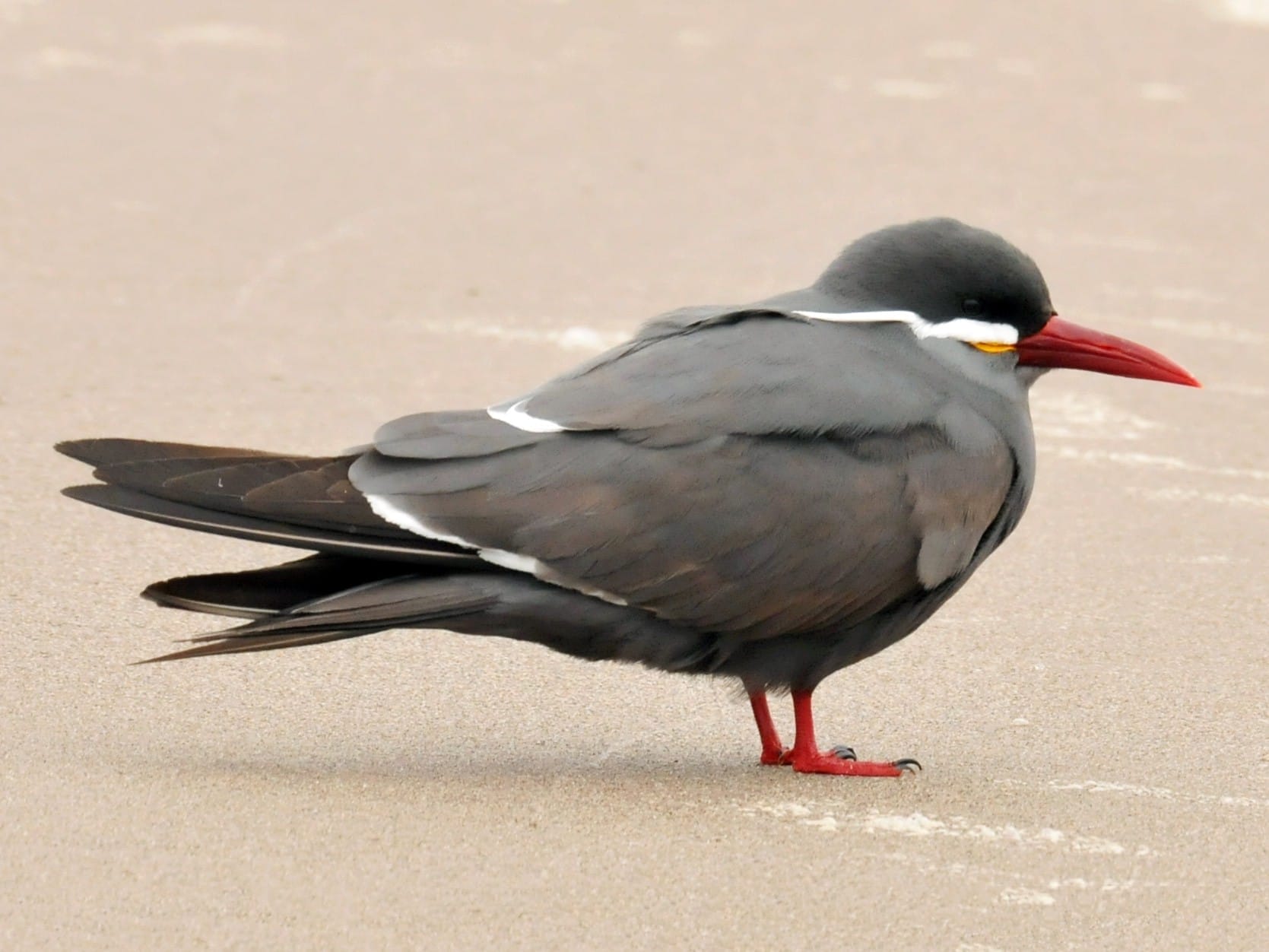
The Inca Tern is a fascinating bird with its striking appearance and impressive hunting skills. It plays a vital role in maintaining the balance of its coastal ecosystem and symbolizes the rich biodiversity found in South America. Efforts must be made to protect and preserve its habitat to ensure the survival of this stunning species.
| Species Name | Inca Tern |
|---|---|
| Scientific Name | Larosterna Inca |
| Habitat | Pacific coast of South America (from Peru to Chile) |
| Appearance | Black and white plumage, bright red beak and feet |
| Long white mustache-like feather tufts on the sides of its head | |
| Wingspan | Approximately 28 inches |
| Weight | 300-400 grams |
| Lifespan | 12-15 years |
| Diet | Small fish and squid |
| Hunting Style | Diving into the ocean from above, skilled hunter |
| Mating Rituals | Elaborate courtship dances, males display bright beaks |
| Population | Estimated population size unknown, not currently at risk |
| Threats | Habitat degradation and destruction due to human activities |
| Nesting Habits | Rocky crevices or caves along the coast, incubation for 4 weeks |
| Parenting | Both parents feed and care for the young |
| Genus | Larosterna |
| Other Species | Five other species of terns in the Larosterna genus |
Bank Myna
The Bank Myna, known by its scientific name Acridotheres Virginians, is a bird species in parts of Asia. It is a medium-sized bird with a wingspan of around 40-45 cm and a length of about 20-25 cm. The Bank Myna is known for its distinctive appearance, with a bright yellow beak and black and white feathers.
It has a lifespan of around 10-12 years and weighs approximately 70-100 grams. The Bank Myna is a social bird often found in large flocks and primarily feeds on insects, fruits, and seeds. It is commonly found in urban areas, such as near banks and other human settlements.
One interesting fact about the Bank Myna is that it is known for its ability to mimic various sounds, including the sounds of other birds and even human voices. This makes it a famous bird for pet owners and bird enthusiasts. However, its ability to mimic sounds has also earned it the nickname “talking myna.”
The Bank Myna faces several threats, with habitat loss and pollution being the biggest threats to its population. Urbanization and deforestation have destroyed its natural habitat, forcing it to adapt to urban areas. It also faces competition for food from other bird species and is vulnerable to predation by larger birds. The Bank Myna typically nests in tree cavities, buildings, or other suitable openings, and it incubates its eggs for around 14 days before they hatch.

The Bank of Myna is estimated to have a stable population in size. Still, its numbers have been declining in certain areas due to habitat loss and hunting for its feathers. Conservation efforts are being made to protect this species and its habitat. Overall, the Bank Myna is a fascinating bird with its unique appearance and ability to mimic sounds. Still, it also faces several challenges that must be addressed for long-term survival.
| Bird Species | Bank Myna (Acridotheres Virginians) |
|---|---|
| Habitat | Parts of Asia |
| Size | Medium-sized |
| Wingspan | Around 40-45 cm |
| Length | About 20-25 cm |
| Appearance | Bright yellow beak, black and white feathers |
| Lifespan | 10-12 years |
| Weight | Approximately 70-100 grams |
| Behavior | Social bird, found in large flocks |
| Diet | Insects, fruits, and seeds |
| Habitat | Urban areas, near banks and human settlements |
| Special Feature | Ability to mimic various sounds, including other birds and human voices |
| Nickname | “Talking myna” |
| Threats | Habitat loss, pollution, competition for food, predation by larger birds |
| Nesting | Tree cavities, buildings, suitable openings |
| Incubation | Around 14 days |
| Population | Stable overall, declining in certain areas |
| Conservation | Efforts to protect species and habitat |
Black-Breasted Thrush
The Black-Breasted Thrush, scientifically known as Turdus dissimilis, is a bird species in certain regions worldwide. These birds primarily feed on insects, fruits, and berries as their prey. A fun fact about the Black-Breasted Thrush is that they are known for their melodic songs, which they use to communicate with other members of their species. The estimated population size of the Black-Breasted Thrush has yet to be accurately known, but it is believed to be stable. However, their biggest threat is habitat loss due to deforestation.
The most distinctive feature of the Black-Breasted Thrush is, as its name suggests, its black breast, which contrasts with its pale grey underparts. They are also known by their other names, such as Abyssinian Thrush or White-Browed Thrush. The wingspan of the Black-Breasted Thrush can reach up to 30 centimeters, and its incubation period lasts around two weeks. They primarily inhabit forests and wooded areas but can also be found in gardens and parks.
Predators of the Black-Breasted Thrush include larger birds of prey, such as hawks or falcons. Their diet consists mainly of insects, fruits, and berries. They are classified as songbirds and belong to the family Turdidae. There are multiple species of thrushes, but the Black-Breasted Thrush is distinct. Their range includes parts of Africa and Asia, such as Ethiopia, Uganda, and India.
The Black-Breasted Thrush typically chooses a well-protected area, such as dense shrubs or bushes, for nesting. They molt their feathers around the age of one year. The coloration of the Black-Breasted Thrush is primarily dark brown or black on the upper body, with a pale grey underbelly. They have feathers as their skin type. A Black-Breasted Thrush’s top speed is unknown, but they are known for their agile flight.
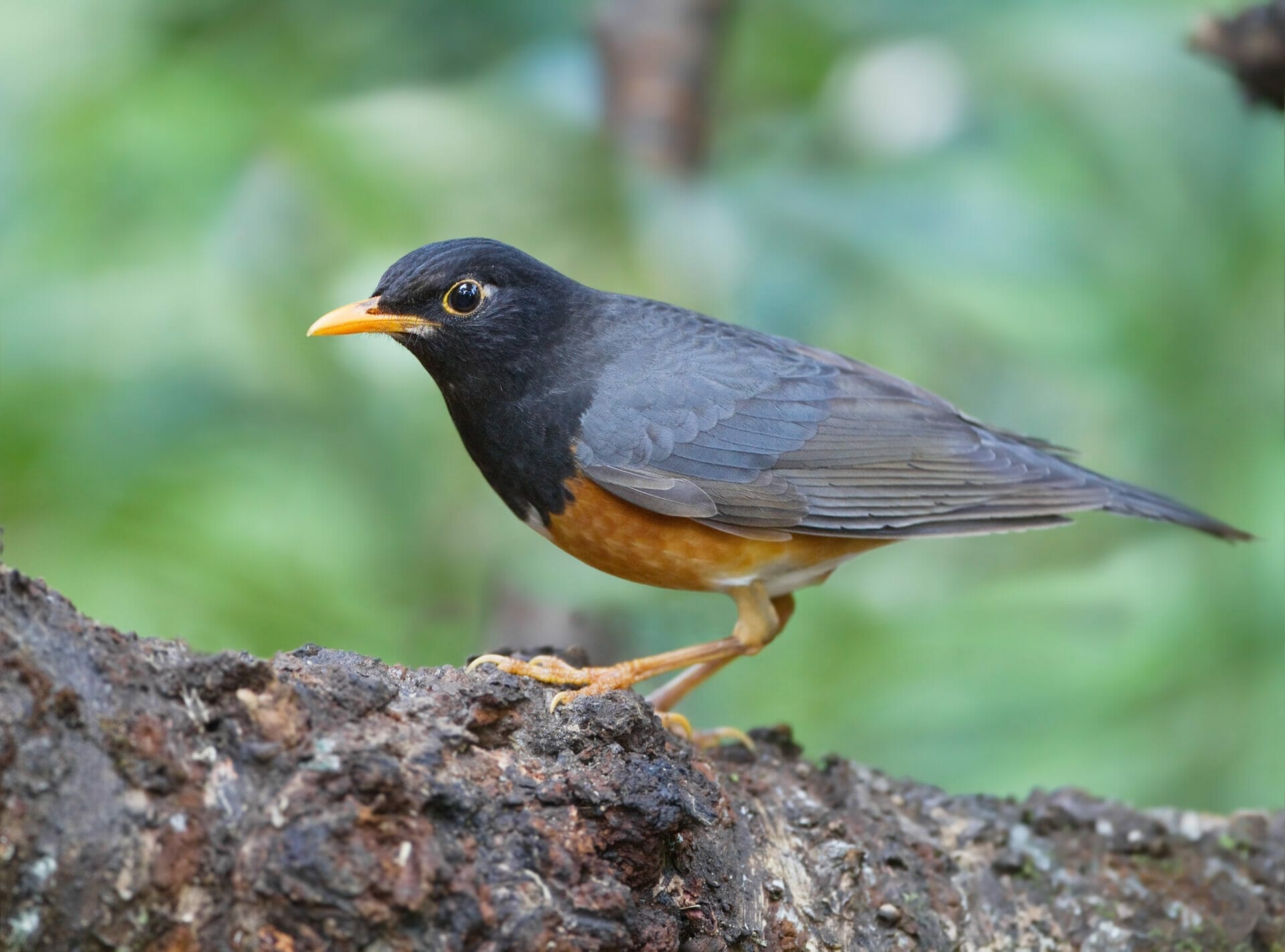
The average lifespan of the Black-Breasted Thrush is approximately 8-9 years. They weigh around 60-100 grams and are 20-25 centimeters long. Overall, the Black-Breasted Thrush is a unique and beautiful bird with its black breast and distinctive features.
| Species Name | Turdus dissimilis |
|---|---|
| Common Names | Black-Breasted Thrush, Abyssinian Thrush, White-Browed Thrush |
| Scientific Classification | Family: Turdidae |
| Habitat | Forests, wooded areas, gardens, parks |
| Range | Parts of Africa (Ethiopia, Uganda) and Asia (India) |
| Diet | Insects, fruits, berries |
| Predators | Larger birds of prey (hawks, falcons) |
| Primary Threat | Habitat loss due to deforestation |
| Population Size | Estimated to be stable, actual size unknown |
| Wingspan | Up to 30 centimeters |
| Incubation Period | Approximately two weeks |
| Nesting Habitat | Well-protected areas (dense shrubs, bushes) |
| Feather Coloration | Dark brown or black (upper body), pale grey (underbelly) |
| Skin Type | Feathers |
| Lifespan | Approximately 8-9 years |
| Weight | 60-100 grams |
| Length | 20-25 centimeters |
| Special Feature | Melodic songs for communication |
| Flight | Agile |
Zebra Finch
The Zebra Finch, known by its scientific name Taeniopygia guttata, is a small bird belonging to the finch family. It is native to Australia and Indonesia’s grassy plains and dry open woodlands. Zebra Finches are known for their unique black and white striped feathers, their most distinctive feature.
These birds have a wingspan of about 20-25 centimeters and a length of around 10-12 centimeters. They typically weigh between 11 and 17 grams. Zebra Finches are small but highly adaptable and can be found in various habitats, including grasslands, shrublands, and farmlands. They are social birds and often form large flocks, especially during breeding.
Zebra Finches feed on seeds and grains and eat small insects and fruits when available. They are preyed upon by various predators, including snakes, birds of prey, and cats. The estimated population size of Zebra Finches is challenging to determine. Still, they are widespread and considered a species of “least concern” by the International Union for Conservation of Nature (IUCN).
An interesting fact about the Zebra Finch is that they are excellent singers with a vast repertoire of calls and songs. They are popular as pets due to their musical vocalizations. The Zebra Finch undergoes molting as it ages, shedding and replacing its feathers. This molt occurs around the age of 3-4 months. These birds have a lifespan of about 5-7 years in the wild but can live up to 10 years in captivity.
The biggest threat to Zebra Finch populations is habitat loss due to urbanization and agricultural expansion. Their grassland and shrubland habitats are being converted into farmlands and urban areas, limiting their available nesting locations. Despite this threat, Zebra Finches are resilient and adaptable and continue to thrive in many parts of their range.
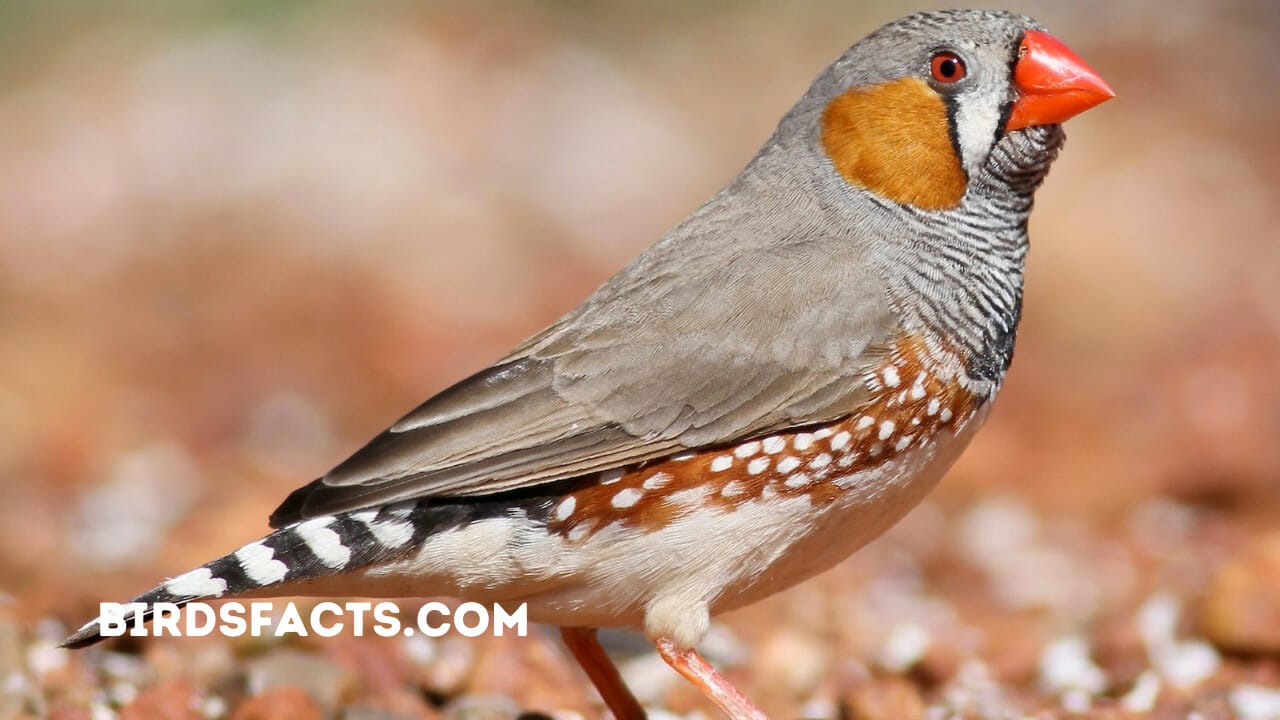
These charismatic birds are delightful with their striking black and white plumage and beautiful songs.
| Species Name | Zebra Finch |
|---|---|
| Scientific Name | Taeniopygia guttata |
| Family | Finch |
| Native Range | Australia, Indonesia |
| Habitat | Grassy plains, dry open woodlands |
| Distinctive Feature | Black and white striped feathers |
| Wingspan | 20-25 centimeters |
| Length | 10-12 centimeters |
| Weight | 11-17 grams |
| Adaptability | Highly adaptable, found in various habitats |
| Social Behavior | Form large flocks, especially during breeding |
| Diet | Seeds, grains, small insects, fruits |
| Predators | Snakes, birds of prey, cats |
| Population Status | “Least concern” (IUCN) |
| Singing Ability | Excellent singers with vast repertoire of calls and songs |
| Molting | Occurs at around 3-4 months of age |
| Lifespan | 5-7 years (wild), up to 10 years (captivity) |
| Threats | Habitat loss due to urbanization and agricultural expansion |
| Conservation Status | Not threatened |
American Robin
The American Robin, scientifically known as Turdus migratorius, is an iconic bird species across North America. Known for its vibrant red breast and melodic song, the American Robin is famous in gardens, parks, and forests. It is a medium-sized songbird with a wingspan of approximately 12-16 inches and a 9-11 inches length. The American Robin has a distinctive feature: its bright orange-red breast and underparts contrast with its gray back and head. This bird is also known for its unique call, a series of clear, musical notes that can carry over long distances.
The American Robin feeds on various prey, including earthworms, insects, fruits, and berries. It can be found in multiple habitats, including forests, woodlands, parks, and gardens. The American Robin is a migratory species, spending its breeding season in North America and migrating to parts of the southern United States and Mexico during winter. It nests in trees, shrubs, and sometimes on artificial structures such as buildings and lampposts. The female robin typically incubates the eggs for about 12-14 days, with both parents sharing the task of feeding the chicks once they hatch.
The estimated population size of the American Robin is challenging to determine, but it is considered to be one of the most abundant bird species in North America. However, despite its widespread distribution, habitat loss and climate change pose significant threats to this species. The American Robin is preyed upon by predators, including snakes, hawks, and domestic cats.
The lifespan of the American Robin is typically around 2-3 years, although some individuals have been known to live longer. The bird molts once a year, usually in late summer or early fall, when its feathers are replaced. The molted feathers are less vibrant in color compared to the breeding plumage. Apart from its red breast, the American Robin has a brownish-gray back, a white eye-ring, and a yellow bill.

Overall, the American Robin is a beloved bird species, celebrated for its beautiful appearance and melodic song. Its presence in gardens and parks adds delight to the natural world, and its migratory behavior symbolizes the changing seasons. However, conservation efforts are necessary to ensure the continued survival of this species in the face of habitat loss and other threats.
| Species Name | American Robin (Turdus migratorius) |
|---|---|
| Description | Medium-sized songbird with red breast and gray back and head |
| Wingspan | Approximately 12-16 inches |
| Length | 9-11 inches |
| Habitat | Forests, woodlands, parks, gardens |
| Prey | Earthworms, insects, fruits, berries |
| Migration | Breeding in North America, winter in southern US and Mexico |
| Nesting | Trees, shrubs, sometimes artificial structures |
| Incubation Period | 12-14 days |
| Parental Care | Both parents feed the chicks |
| Population | Considered one of the most abundant bird species in NA |
| Threats | Habitat loss, climate change, predation |
| Lifespan | 2-3 years (some individuals may live longer) |
| Molting | Once a year in late summer or early fall |
| Appearance | Red breast, gray back, white eye-ring, yellow bill |
| Significance | Beloved for appearance and song, symbolizes changing seasons |
| Conservation Status | Conservation efforts necessary for survival |
Green Wood Hoopoe
The Green Wood Hoopoe, scientifically known as Phoeniculus purpureus, is a fascinating bird species in Africa. It is recognized for its vibrant green feathers and striking black and white striped wings. This bird primarily feeds on insects, spiders, small reptiles, and berries. The Green Wood Hoopoe is known for its unique nesting habits, as it tunnels into tree trunks to create its own nest.
Its estimated population size is relatively stable, but its most significant threat is deforestation and habitat loss. One of the most distinctive features of the Green Wood Hoopoe is its vibrant green plumage and its long, curved bill. It is also commonly referred to as the “Red-billed Wood Hoopoe” due to the reddish coloration of its account. This bird has a wingspan of approximately 40cm and an incubation period of 17 to 20 days.
The Green Wood Hoopoe is commonly found in woodland areas, forest edges, and savannahs. It faces potential threats from larger raptors and other predators. As for its diet, the Green Wood Hoopoe primarily feeds on insects, spiders, small reptiles, and berries. It belongs to the family Phoeniculidae and is one of the six species of Wood Hoopoes. The Green Wood Hoopoe is most commonly found in sub-Saharan Africa and can be observed in Kenya, Tanzania, South Africa, and Zimbabwe.

It builds its nest in tree trunks and typically molts its feathers at around two or three years of age. The plumage of this bird is predominantly green, with black and white markings on its wings. It has dry and scaly skin and can fly up to 30 miles per hour. The lifespan of the Green Wood Hoopoe is approximately 10 years, and it weighs around 60-90 grams. It has a body length of roughly 30cm and a wingspan of about 40cm.
| Species Name | Green Wood Hoopoe |
|---|---|
| Scientific Name | Phoeniculus purpureus |
| Description | A fascinating bird species found in Africa |
| Feather Color | Vibrant green with black and white striped wings |
| Diet | Insects, spiders, small reptiles, berries |
| Nesting Habits | Tunnels into tree trunks to create its nest |
| Population Size | Relatively stable |
| Threats | Deforestation, habitat loss |
| Distinctive Features | Vibrant green plumage, long curved bill |
| Common Name Variation | Red-billed Wood Hoopoe |
| Wingspan | Approximately 40cm |
| Incubation Period | 17 to 20 days |
| Habitat | Woodland areas, forest edges, savannahs |
| Predators | Larger raptors and other predators |
| Family | Phoeniculidae |
| Distribution | Sub-Saharan Africa (Kenya, Tanzania, South Africa, Zimbabwe) |
| Nesting | Builds nest in tree trunks |
| Feather Molting | Occurs at around two or three years of age |
| Plumage | Predominantly green with black and white wing markings |
| Skin Type | Dry and scaly |
| Flight Speed | Up to 30 miles per hour |
| Lifespan | Approximately 10 years |
| Weight | 60-90 grams |
| Body Length | Roughly 30cm |
Eclectus Parrot
The Eclectus Parrot, scientifically known as Eclectus roratus, is a stunning species of parrot known for its vibrant plumage. These parrots are primarily found in the tropical rainforests of Australia, Indonesia, and New Guinea. Their unique and distinctive feature sets them apart from other parrot species – the males and females have entirely different coloration.
The males have bright green feathers, while the females have a combination of red and blue plumage. This difference in appearance makes it easy to identify the male and female Eclectus Parrots. The Eclectus Parrot is a social bird commonly found in small groups or flocks, often seen flying together for food and water.
The Eclectus Parrot feeds predominantly on fruits, flowers, seeds, and nuts, making them essential for seed dispersal in their habitats. Their diet and other factors like habitat loss and hunting have significantly threatened their population size. It is estimated that around 50,000 to 100,000 Eclectus Parrots are currently in the wild. Efforts are being made to protect their habitats and raise awareness about the importance of conserving these beautiful birds.
These parrots have a wingspan of about 20 inches and can live up to 30 years in the wild. They are a relatively large parrot species, with an average weight of 400-480 grams and 14-20 inches long. The Eclectus Parrots are known for their ability to mimic sounds and human speech, making them popular pets among bird enthusiasts.
Regarding nesting, Eclectus Parrots typically choose hollow cavities in trees as their preferred nesting locations. The incubation period for their eggs is around 28 days, and the chicks will start molting at around 12 weeks of age. They have a vibrant range of colors, with males displaying bright green plumage and females showcasing a combination of red and blue feathers. Their skin type is covered in beautiful feathers, and they can reach up to 35 miles per hour in flight.

The Eclectus Parrot is a remarkable species with its striking coloration and distinctive features. It is essential to protect their habitats and raise awareness about the threats they face to ensure the conservation of this beautiful bird.
| Species Name | Eclectus Parrot |
|---|---|
| Scientific Name | Eclectus roratus |
| Habitat | Tropical rainforests of Australia, Indonesia, and New Guinea |
| Coloration | Males: Bright green feathers<br> Females: Combination of red and blue plumage |
| Social Behavior | Found in small groups or flocks |
| Diet | Fruits, flowers, seeds, and nuts |
| Population Size | Estimated 50,000 to 100,000 individuals in the wild |
| Wingspan | Approximately 20 inches |
| Lifespan | Up to 30 years in the wild |
| Size | Average weight: 400-480 grams<br> Average length: 14-20 inches |
| Special Abilities | Mimics sounds and human speech |
| Nesting | Prefers hollow cavities in trees |
| Incubation Period | Around 28 days |
| Chicks’ Molting | Starts at around 12 weeks of age |
| Flight Speed | Up to 35 miles per hour |
Bateleur
The Bateleur, scientific name Terathopius ecaudatus, is a species of bird known for its distinctive features and unique characteristics. The Bateleur is a bird of prey that primarily feeds on small to medium-sized mammals, birds, and reptiles. Its diet includes small rodents, lizards, snakes, and even young birds.
With an estimated population size of around 10,000 individuals, the Bateleur is considered near-threatened due to habitat loss and degradation. Its most distinctive feature is its wingspan, which can reach up to 1.8 meters. This bird is also known by other names such as the “short-tailed eagle” or “gymnogene.”
The Bateleur is found throughout sub-Saharan Africa, occupying various habitats, including savannas, grasslands, and open woodlands. Its predators include larger raptors such as eagles and owls. The Bateleur is a diurnal species that is active during the day. It has been observed to engage in aerial displays and acrobatics during courtship rituals. The Bateleur has a lifespan of around 20-30 years in the wild, with females typically living longer than males.
It has an average weight of 2-3 kilograms and a length of about 55-70 centimeters. The Bateleur molts at around 4-5 years of age, changing coloration during this process. It has a unique coloration: a black body, red facial skin, and distinctive white wing patches. The Bateleur has a top speed of around 56 kilometers per hour, allowing it to hunt and capture its prey swiftly.
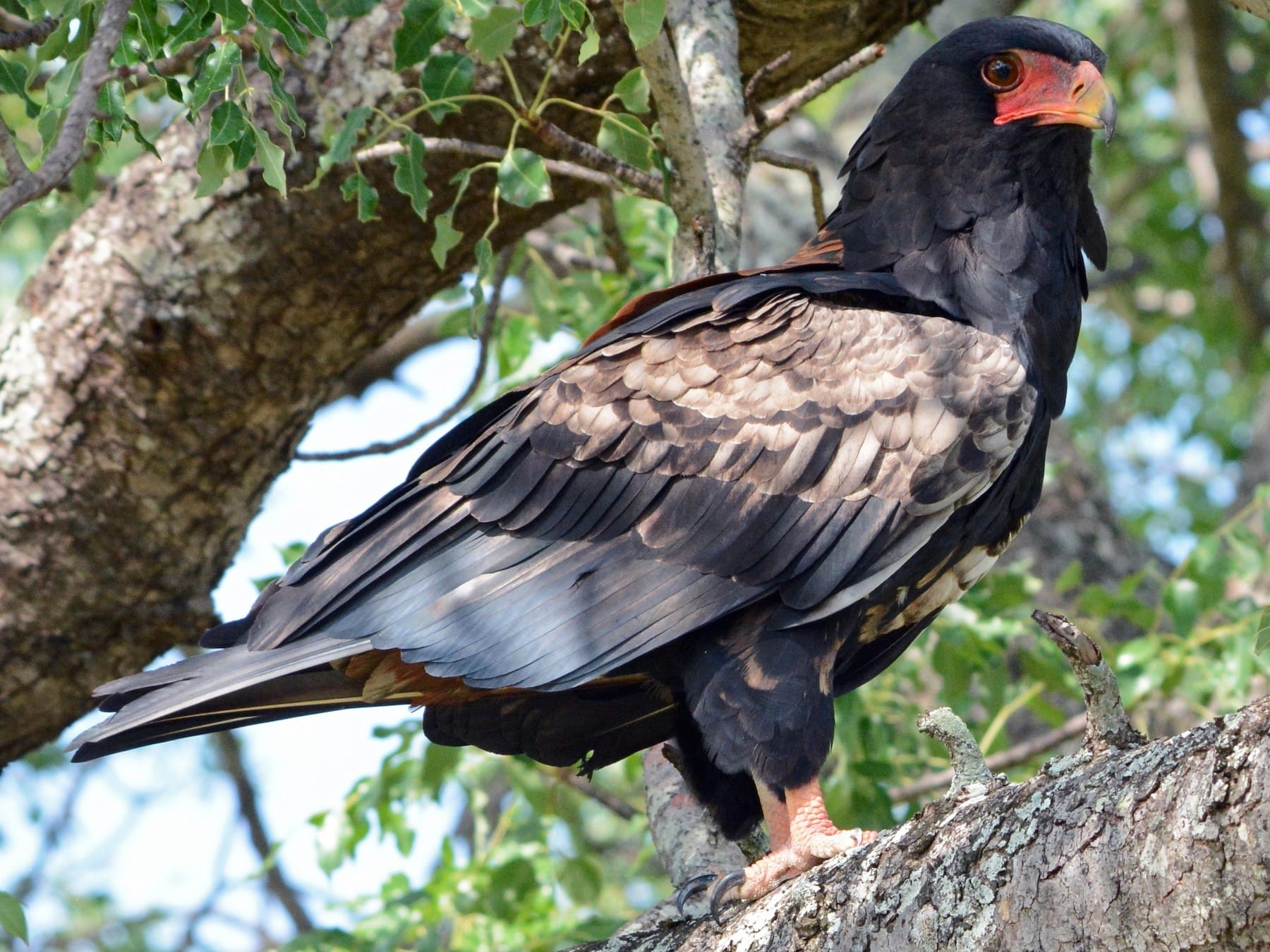
Overall, the Bateleur is a remarkable bird species with various exciting features and adaptations that make it well-suited for its predatory lifestyle in the African savannah.
| Species Name | Bateleur (Terathopius ecaudatus) |
|---|---|
| Diet | Small to medium-sized mammals, birds, and reptiles |
| Population Size | Approximately 10,000 individuals |
| Conservation Status | Near-threatened |
| Wingspan | Up to 1.8 meters |
| Other Names | Short-tailed eagle, gymnogene |
| Habitat | Sub-Saharan Africa (savannas, grasslands, open woodlands) |
| Predators | Larger raptors such as eagles and owls |
| Activity | Diurnal (active during the day) |
| Lifespan | 20-30 years in the wild (females typically live longer) |
| Weight | 2-3 kilograms |
| Length | 55-70 centimeters |
| Molting Age | Around 4-5 years |
| Coloration | Black body, red facial skin, white wing patches |
| Top Speed | Approximately 56 kilometers per hour |
American Goldfinch
The American Goldfinch, scientifically known as Spinus tristis, is a small, vibrant bird across North America. This species is known for its distinctively bright yellow plumage, making it easily recognizable. The American Goldfinch is mainly insectivorous, feeding on various seeds, berries, and insects. With an estimated population size of around 42 million individuals, these birds can be found in open fields, meadows, and woodlands.
Their preferred nesting locations include shrubs and trees, where they build their nests to protect their eggs. The incubation period for the American Goldfinch lasts about 12-14 days, after which the chick hatch and are cared for by their parents. Despite their small size, American Goldfinches have a relatively long lifespan, with an average of 3-6 years in the wild.
One interesting fact about American Goldfinches is that they undergo a molt in late summer, where a more subdued olive-brown color replaces their bright yellow feathers. This molt is believed to help them camouflage with their surroundings as they prepare for the upcoming winter season. Additionally, their wingspan can reach 8-9 inches long, making them agile flyers. However, their small size and vibrant plumage make them vulnerable to predation by larger birds, such as hawks and owls.
The biggest threat to the American Goldfinch population is habitat loss due to destroying their preferred nesting locations. As trees and shrubs are cleared for urban development, the availability of suitable habitats decreases, negatively impacting their numbers. Conservation efforts are being made to protect and restore these habitats to ensure the survival of this species.
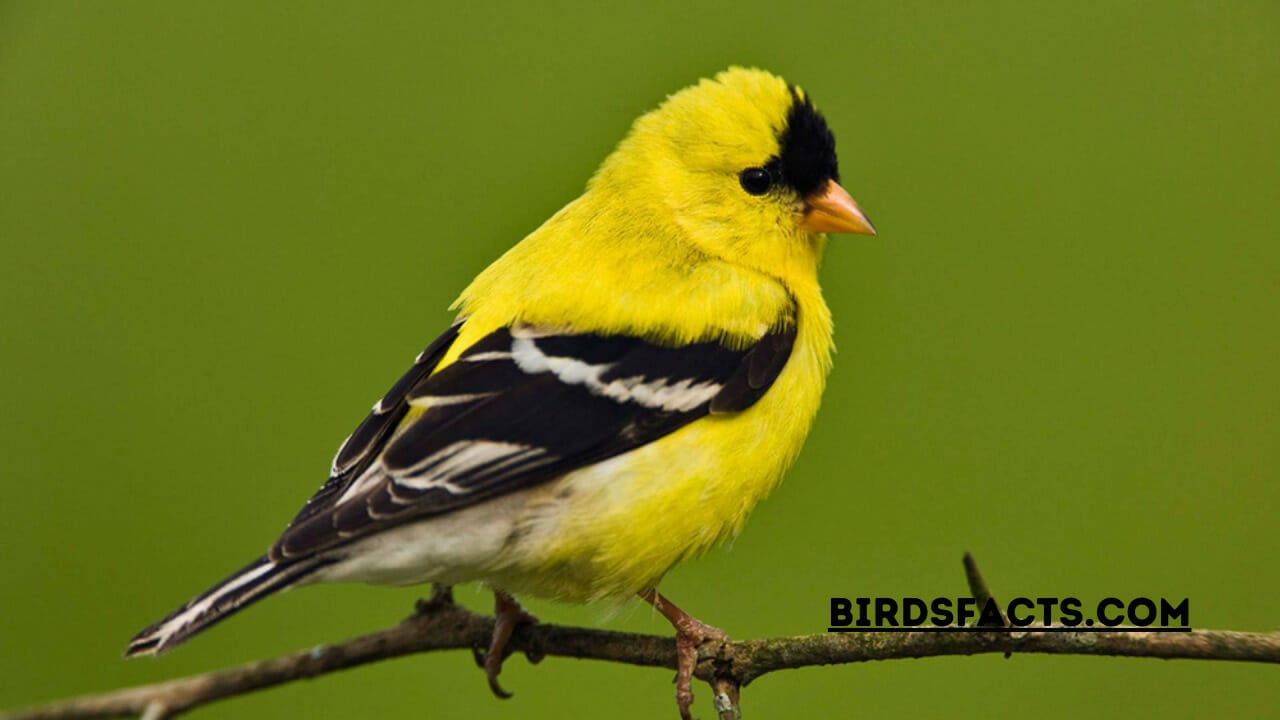
The American Goldfinch is a charming bird with its vibrant yellow plumage and agile flying ability. With an estimated population of around 42 million, these birds can be found across North America in various habitats. However, habitat loss remains the biggest threat to their survival. Through conservation efforts and habitat restoration, the American Goldfinch is hoped to continue to thrive.
| Species Name | American Goldfinch |
|---|---|
| Scientific Name | Spinus tristis |
| Description | Small, vibrant bird with distinctively bright yellow plumage |
| Habitat | Open fields, meadows, woodlands |
| Preferred Nesting | Shrubs, trees |
| Diet | Insects, seeds, berries |
| Population Size | Approximately 42 million individuals |
| Lifespan | 3-6 years (average) in the wild |
| Incubation Period | 12-14 days |
| Molt | Late summer, olive-brown color replaces yellow feathers |
| Wingspan | 8-9 inches |
| Predators | Larger birds such as hawks and owls |
| Threats | Habitat loss due to destruction of nesting locations |
| Conservation Efforts | Protecting and restoring habitats |
| Conservation Goal | Ensuring the survival and thriving of the species |
ʻiʻiwi
The ʻiʻiwi, scientifically known as Drepanis coccinea, is a small bird species native to the Hawaiian Islands. It is known for its vibrant red plumage, long curved bill, and distinctive song. The ʻiʻiwi primarily feeds on nectar from the flowers of native Hawaiian plants, making it an essential pollinator in its ecosystem.
They also consume small insects and spiders as a source of protein. The estimated population size of the ʻiʻiwi is currently around 350,000 individuals. However, this number has been declining due to habitat loss and the spread of avian diseases, such as avian malaria. This bird species is particularly susceptible to these diseases because it has a low tolerance for mosquitoes, which transmit them.
The biggest threat to the survival of the ʻiʻiwi is the destruction and degradation of its native forest habitat. As the forests are cleared for agriculture and development, the ʻiʻiwi loses its food source and nesting sites. In addition, introducing non-native predators, such as rats and cats, increases the predation pressure on the ʻiʻiwi population. These factors have contributed to the decline in the numbers of this iconic Hawaiian bird.
One of the most distinctive features of the ʻiʻiwi is its long, curved bill, which has evolved for accessing nectar from tubular flowers. This adaptation allows the ʻiʻiwi to reach deep into the flowers and extract the nectar using its brush-tipped tongue. It is sometimes called the “Hawaiian honeycreeper” due to its feeding habits. The ʻiʻiwi has an approximately 7-8 wingspan and weighs around 16 grams. It has a lifespan of about 5-7 years in the wild.
The ʻiʻiwi is found only in the Hawaiian Islands, specifically in Hawaii, Maui, and Kauai. It prefers to inhabit native forest habitats between 3,000 and 6,000 feet. The ʻiʻiwi constructs its nests in tree branches using twigs, grass, and moss. The female typically incubates the eggs for about 15 days. After hatching, the chicks remain in the nest for approximately 18-22 days before fledging. At around 6 months of age, the young birds molt into their adult plumage. This molting process is unique to the ʻiʻiwi, as it transitions from its drab gray juvenile feathers to its vibrant red adult feathers.
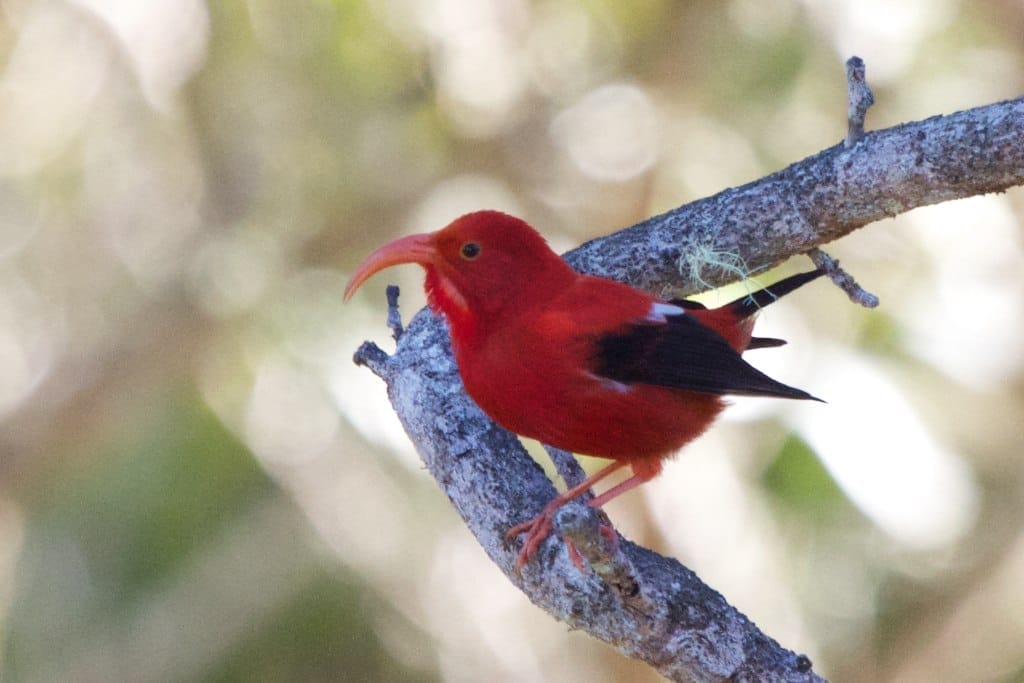
The ʻiʻiwi is a unique and vital bird species in the Hawaiian Islands. Its bright red plumage, specialized bill, and important ecological role make
| Species Name | Drepanis coccinea |
|---|---|
| Common Name | ʻIʻiwi |
| Native to | Hawaiian Islands |
| Description | Small bird species with vibrant red plumage, long curved bill, and distinctive song |
| Feeding Habits | Nectar from native Hawaiian plants, small insects, and spiders |
| Population Size | Approximately 350,000 individuals |
| Threats | Habitat loss, avian diseases, non-native predators |
| Adaptations | Long curved bill for accessing nectar, brush-tipped tongue |
| Wingspan | Approximately 7-8 inches |
| Weight | Around 16 grams |
| Lifespan | 5-7 years in the wild |
| Habitat | Native forests between 3,000 and 6,000 feet |
| Nesting Habits | Nests in tree branches using twigs, grass, and moss |
| Incubation Period | About 15 days |
| Fledging Period | Approximately 18-22 days |
| Plumage | Juvenile feathers are drab gray, adults have vibrant red plumage |
Wattled Curassow
The Wattled Curassow, scientifically known as Crax globulosa, is a fascinating bird species. It is a large bird with a distinctive feature of wattles hanging from its neck, giving it a unique appearance. The Wattled Curassow primarily feeds on fruits, seeds, and insects but has also been known to eat small vertebrates.
Its estimated population size is unknown, but it is believed to be under threat due to habitat loss and hunting. One interesting fact about this bird is that it is monogamous, forming a long-term pair bond with a single mate. It is also known as “bloody wood quail” and can be found in the western Amazon basin of South America.
Its habitat includes lowland rainforests and tropical evergreen forests. Predators of the Wattled Curassow include large mammalian predators such as jaguars and ocelots. The bird has a wingspan of approximately 70-80 cm and an incubation period of around 30 days. When it comes to molting, the Wattled Curassow typically molts between 1-2 years of age.
The bird is characterized by its black plumage, white underparts, and a notable red wattle. Its skin type is thick and feathered. Despite its size, the Wattled Curassow is not known for its speed, with a top speed of around 15-20 km/h. Its lifespan is around 10-15 years in the wild. The bird weighs approximately 2-3 kg and reaches a length of about 85-90 cm.

Overall, the Wattled Curassow is a fascinating bird with unique features and behaviors, but its population is at risk due to various threats.
| Attribute | Information |
|---|---|
| Common Name | Wattled Curassow |
| Scientific Name | Crax globulosa |
| Description | Large bird with wattles hanging from its neck |
| Diet | Fruits, seeds, insects, and occasionally small vertebrates |
| Population Size | Unknown, but believed to be under threat |
| Mating Behavior | Monogamous, forms long-term pair bond with a single mate |
| Alternative Names | Bloody Wood Quail |
| Habitat | Lowland rainforests and tropical evergreen forests |
| Predators | Jaguars, ocelots, and other large mammalian predators |
| Wingspan | Approximately 70-80 cm |
| Incubation Period | Around 30 days |
| Molting | Typically occurs between 1-2 years of age |
| Plumage | Black with white underparts and a notable red wattle |
| Skin Type | Thick and feathered |
| Speed | Top speed of around 15-20 km/h |
| Lifespan | Around 10-15 years in the wild |
| Weight | Approximately 2-3 kg |
| Length | About 85-90 cm |
Red Lory
The Red Lory, known by its scientific name Eos bore, is a vibrant and captivating bird species. This beautiful parrot is mainly found in Indonesia’s rainforests, specifically Maluku and Papua. Its most distinctive feature is its bright red plumage, which covers its entire body, except for its beak and legs. The Red Lory has a wingspan of about 11 inches and can grow up to 12 inches in length. It has a weight range of 150 to 200 grams.
The Red Lory primarily feeds on nectar, pollen, berries, fruits, and insects. It has a specialized tongue that allows it to extract nectar from flowers. Additionally, this species is known for being playful and social. They are often seen in small flocks, chirping and exhibiting their acrobatic abilities.
The estimated population size of the Red Lory is unknown, but it is believed to be declining due to habitat loss and the pet trade. This species is listed as near threatened. Its most significant threat is deforestation, as it relies on the rainforest for its habitat and food sources. Logging activities and land conversion for agriculture have significantly reduced the available habitat for the Red Lory.
Regarding reproduction, the Red Lory typically nests high up in the tree canopy. The female usually lays two eggs and takes turns with the male incubating them. The eggs hatch after approximately 25 days. After reaching maturity, these birds undergo molting, where their old feathers are shed and replaced with new ones. The Red Lory has a lifespan of about 20 to 30 years in captivity.
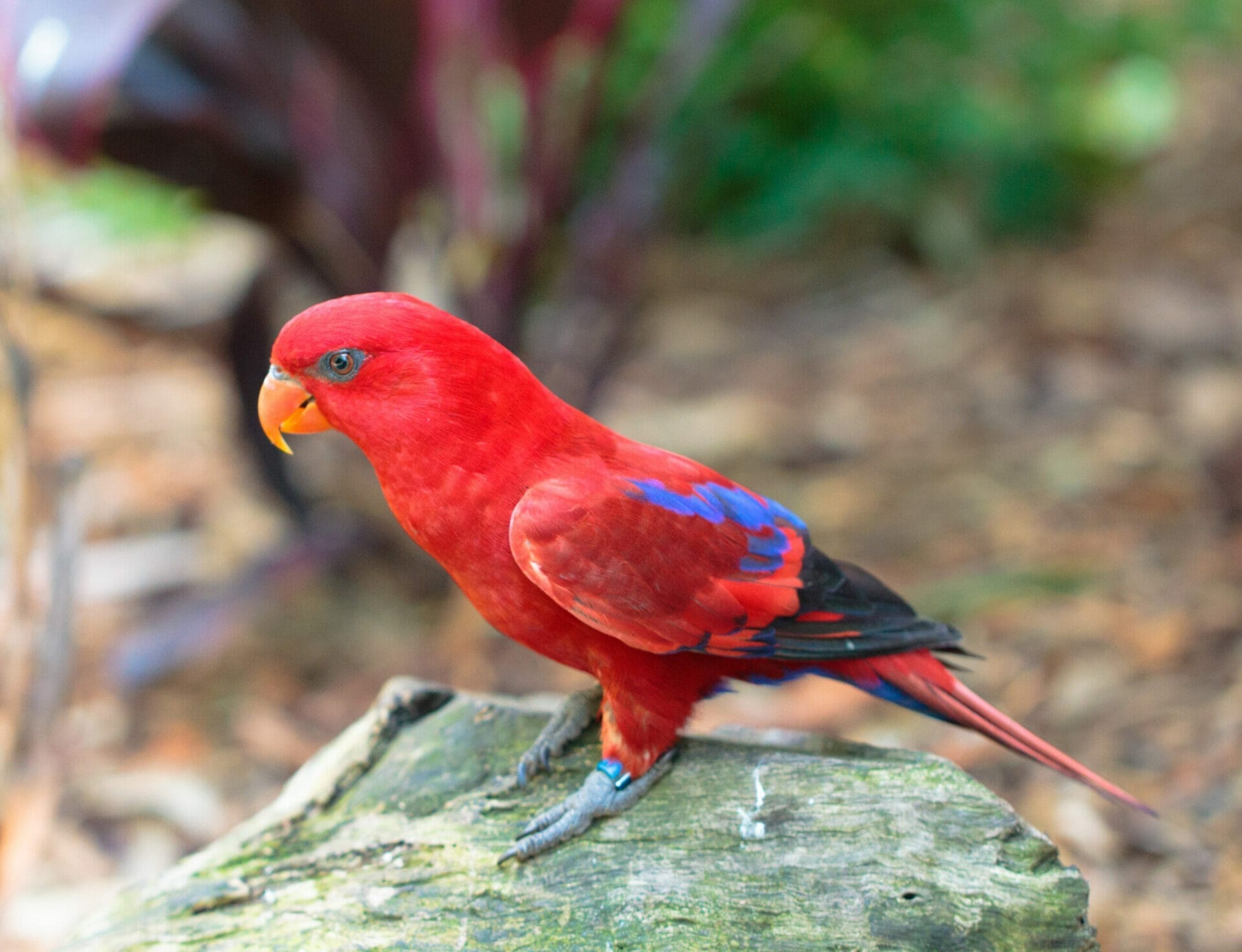
Overall, the Red Lory is a fascinating and colorful species that adds beauty to the tropical rainforests of Indonesia. However, urgent conservation efforts are needed to protect their natural habitat and ensure long-term survival.
| Attribute | Information |
|---|---|
| Scientific Name | Eos bore |
| Common Name | Red Lory |
| Habitat | Indonesia’s rainforests, specifically Maluku and Papua |
| Plumage Color | Bright red |
| Wingspan | Approximately 11 inches |
| Length | Up to 12 inches |
| Weight Range | 150 to 200 grams |
| Diet | Nectar, pollen, berries, fruits, and insects |
| Social Behavior | Playful and social, often seen in small flocks |
| Conservation | Near threatened, declining due to habitat loss and pet trade |
| Main Threat | Deforestation |
| Reproduction | Nests high up in the tree canopy, female lays two eggs |
| Incubation Period | Approximately 25 days |
| Lifespan | 20 to 30 years in captivity |
Common Waxbill
The Common Waxbill, scientifically known as Estrilda Astrid, is a small bird species found mainly in sub-Saharan Africa. It is one of the most colorful and striking birds, with its vibrant red bill and distinctive plumage. This bird primarily preys on seeds and small insects, making it an omnivorous species. Interestingly, the Common Waxbill is known for its ability to eat upside down, using its feet to hold onto branches. Despite its small size, this bird has a significant population size, with estimates ranging from several thousand to several million individuals. However, its most significant threat is the loss of its natural habitat due to deforestation and urbanization.
The most distinctive feature of the Common Waxbill is its bright red bill, which stands out among its colorful feathers. Other names for this bird include the African waxbill and the black-rumped waxbill. It has a wingspan of around six inches and incubates its eggs for about two weeks. The Common Waxbill is primarily found in grassy savannahs, woodlands, and agricultural areas. It is preyed upon by raptors, such as hawks and falcons, as well as snakes and small mammals.
The diet of the Common Waxbill consists mainly of seeds, but it also supplements its diet with insects during the breeding season to provide protein for its chicks. This bird belongs to the Estrildidae family and is one of over 60 species of waxbills. Its common name, “Common Waxbill,” reflects its widespread presence and abundance across its range. The average lifespan of the Common Waxbill is around three to four years. It weighs approximately 10 grams and measures around 10 centimeters in length.

The Common Waxbill is a small yet vibrant bird species in sub-Saharan Africa. Its bright red bill and distinct plumage make it a visually appealing bird. Despite facing threats to its habitat, this species has managed to maintain a relatively large population size. With its ability to eat while upside down and its diverse diet, the Common Waxbill is undoubtedly an exciting and adaptable bird.
| Common Waxbill Information | |
|---|---|
| Scientific Name | Estrilda Astrid |
| Common Names | Common Waxbill, African waxbill, black-rumped waxbill |
| Habitat | Grass savannahs, woodlands, agricultural areas |
| Distribution | Sub-Saharan Africa |
| Size | Length: 10 centimeters, Weight: 10 grams |
| Wingspan | Approximately 6 inches |
| Diet | Seeds, supplemented with insects during breeding season |
| Preyed Upon By | Raptors (hawks, falcons), snakes, small mammals |
| Family | Estrildidae |
| Lifespan | Around 3 to 4 years |
| Notable Features | Bright red bill, vibrant plumage, ability to eat upside down |
| Population Size | Several thousand to several million individuals |
| Threats | Habitat loss due to deforestation and urbanization |
Crowned Hornbill
The Crowned Hornbill, scientifically known as Tockus alboterminatus, is a fascinating bird species in various African locations. These birds primarily feed on insects, fruits, and small animals, making them opportunistic predators. A fun fact about the Crowned Hornbill is that they have a unique nesting behavior where the female seals herself inside a tree cavity during incubation, leaving only a tiny opening for the male to pass food through.
This ensures the safety of the eggs and chicks from potential predators. The estimated population size of the Crowned Hornbill is relatively unknown, but it is believed to decrease due to habitat loss and hunting. Their most distinctive feature is the large, yellowish-white crown on their heads, giving them their name.
Other names, such as the crowned guineafowl or crowned tinkerbird, also know them. The Crowned Hornbill has a wingspan of around 35-40 inches and predominantly inhabits forested areas, savannahs, and woodlands. These birds face threats from larger predators like eagles and snakes. In terms of diet, they consume various food, including fruits, insects, small reptiles, and even small mammals.
The Crowned Hornbill belongs to the family Bucerotidae and is one of the many species within this family. They are commonly referred to as hornbills. In terms of physical appearance, they have a black body with white underparts, and their beaks are long and curved downwards. They weigh around 600-900 grams and can reach a length of about 55-60 centimeters. The average lifespan of a Crowned Hornbill in the wild is about 20-30 years.
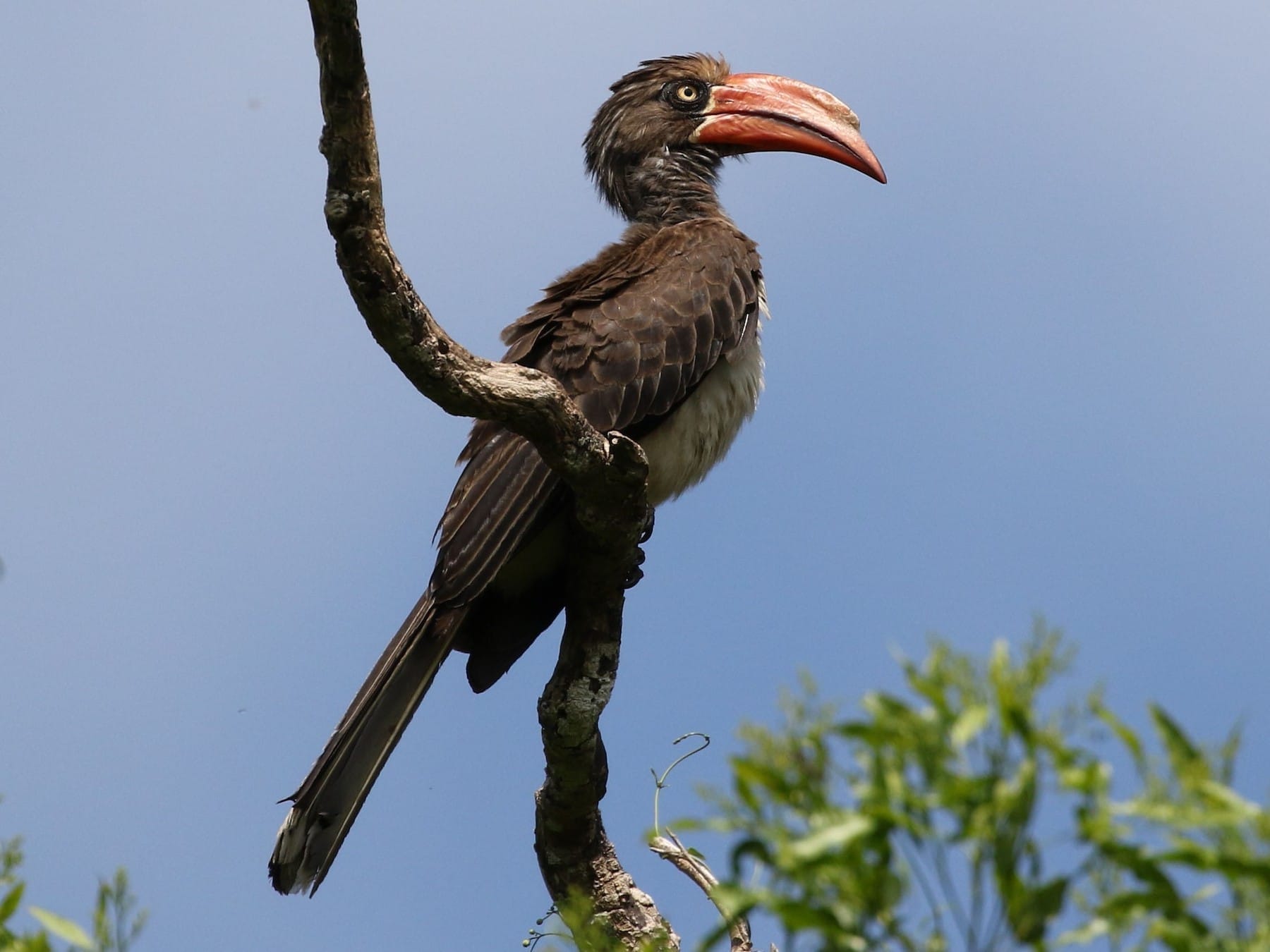
Overall, the Crowned Hornbill is a remarkable bird with its distinctive crown and unique nesting behavior, but its population is at risk due to various threats.
| Species Name | Crowned Hornbill |
|---|---|
| Scientific Name | Tockus alboterminatus |
| Other Names | Crowned guineafowl, Crowned tinkerbird |
| Habitat | Forested areas, savannahs, woodlands |
| Diet | Insects, fruits, small animals |
| Nesting Behavior | Female seals herself inside a tree cavity, leaving a small opening for the male to pass food through |
| Population | Estimated population size unknown, believed to be decreasing due to habitat loss and hunting |
| Distinctive Feature | Large, yellowish-white crown on the head |
| Wingspan | Approximately 35-40 inches |
| Threats | Habitat loss, hunting, predation by eagles and snakes |
| Family | Bucerotidae (Hornbills) |
| Physical Appearance | Black body with white underparts, long and curved downward beaks |
| Weight | Around 600-900 grams |
| Length | About 55-60 centimeters |
| Lifespan | 20-30 years in the wild |
Great Blue Heron
The Great Blue Heron, with its scientific name Ardea herodias, is a fascinating bird found in various parts of North and Central America. This majestic creature has several exciting features and characteristics. Its most distinctive feature is its long, slender neck, allowing it to fish in shallow waters expertly. The Great Blue Heron has a wingspan of around 6 feet, making it one of the most giant birds in North America. Despite its large size, it can fly gracefully and reach up to 30 miles per hour.
The Great Blue Heron primarily feeds on small fish but eats amphibians, crustaceans, insects, and even small mammals. It is a patient hunter, standing still for long periods before striking its prey with lightning-fast precision. While it is not considered endangered, the Great Blue Heron faces habitat loss and pollution threats.
These majestic birds can be found in various habitats, including wetlands, swamps, rivers, and lakes. They often build their nests in tall trees or on the ground, typically near water sources. The Great Blue Heron is known for its beautiful plumage, mainly blue-gray. In the breeding season, adults develop long plumes on their heads and backs.
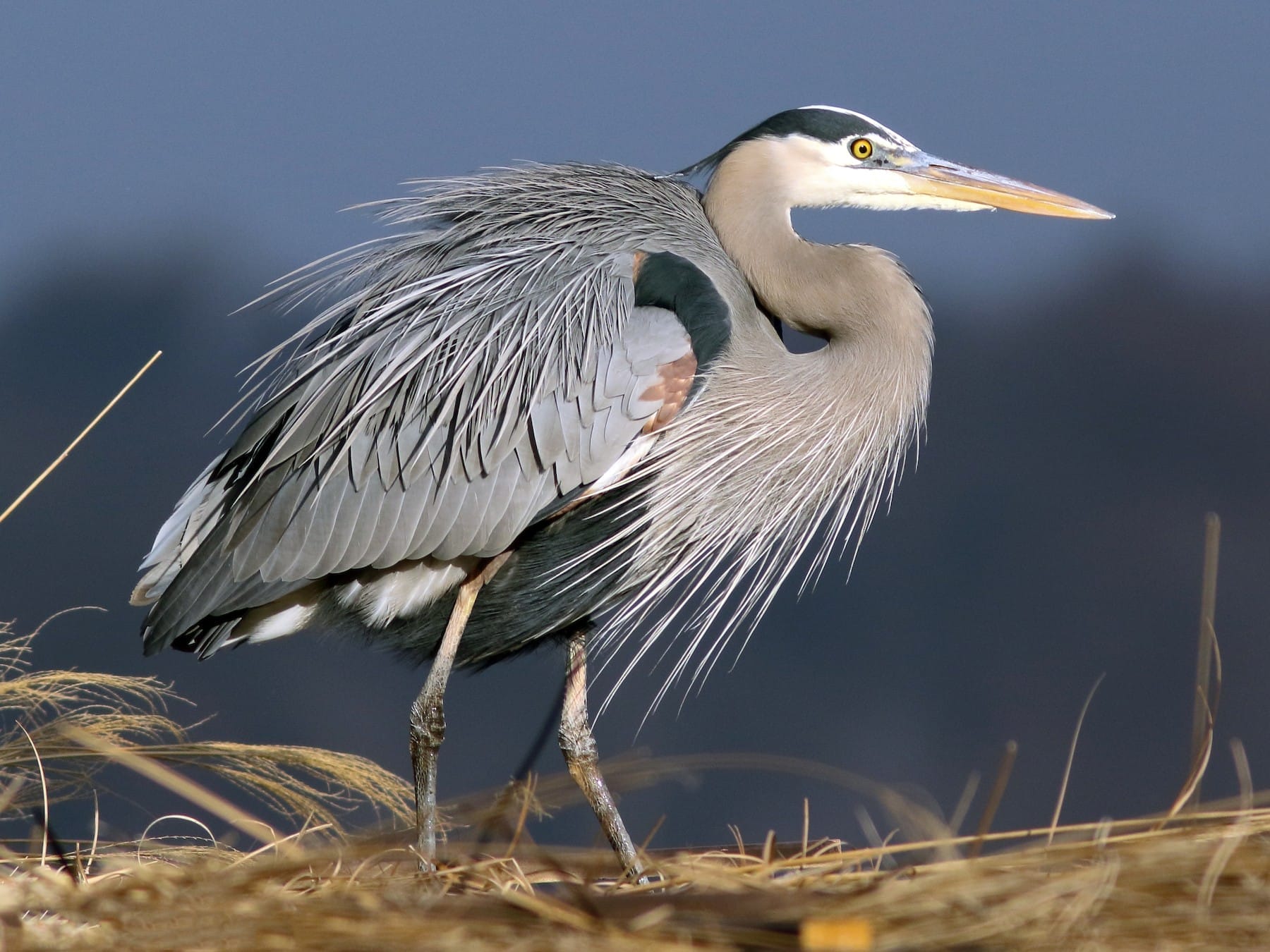
The Great Blue Heron has a long lifespan, with some individuals living up to 15 years in the wild. They reach maturity at around 3 years of age and start molting at about 1 year old. This bird can weigh anywhere from 4 to 7 pounds and can measure between 3.2 to 4.5 feet in length. With an estimated population of around 400,000 individuals, the Great Blue Heron remains a common sight in many wetland areas.
| Feature | Description |
|---|---|
| Common Name | The Great Blue Heron |
| Scientific Name | Ardea herodias |
| Geographic Range | North and Central America |
| Distinctive Feature | Long, slender neck for expert fishing in shallow waters |
| Wingspan | Approximately 6 feet |
| Flight Speed | Up to 30 miles per hour |
| Diet | Small fish, amphibians, crustaceans, insects, small mammals |
| Hunting Behavior | Patient hunter, strikes prey with lightning-fast precision |
| Conservation Status | Not considered endangered, but faces threats from habitat loss and pollution |
| Habitats | Wetlands, swamps, rivers, lakes |
| Nesting Behavior | Builds nests in tall trees or on the ground, near water sources |
| Plumage | Mainly blue-gray, with long plumes on the heads and backs of adults during breeding season |
| Lifespan | Up to 15 years in the wild |
| Maturity Age | Around 3 years |
| Molting Age | Starts at about 1 year old |
| Weight | 4 to 7 pounds |
| Length | 3.2 to 4.5 feet |
| Population Estimate | Approximately 400,000 individuals |
White-tailed Tropicbird
The White-tailed Tropicbird, known by its scientific name Phaethon lepturus, is a stunning bird in various locations worldwide. This species is known for its distinctive white plumage and long, white tail feathers, which give it its name. It has a wingspan of about 36 to 39 inches and can reach lengths up to 30 inches.
The White-tailed Tropicbird primarily feeds on fish and squid, using its sharp, hooked beak to catch its prey. These birds are considered an aquatic species, spending most of their time at sea and only coming to land for nesting.
Speaking of nesting, White-tailed Tropicbirds typically choose remote rocky islands as their nesting locations, often in large colonies. Regarding reproduction, males and females incubate the eggs, which takes around 40 days. Once the chicks hatch, they remain in the nest for approximately 70 to 75 days before fledging.
The estimated population size of the White-tailed Tropicbird is challenging to determine accurately, but it is believed to be relatively stable. However, their biggest threat comes from introduced predators, such as rats and cats, which feed on their eggs and young chicks. In terms of lifespan, these birds can live for up to 20 years in the wild.
Their top speed is around 40 miles per hour, allowing them to glide through the air as they search for food swiftly. The White-tailed Tropicbird is known for its beautiful white plumage, which covers its entire body and its long, streamer-like tail feathers. Its skin is covered in feathers, and its coloration remains consistent throughout life.
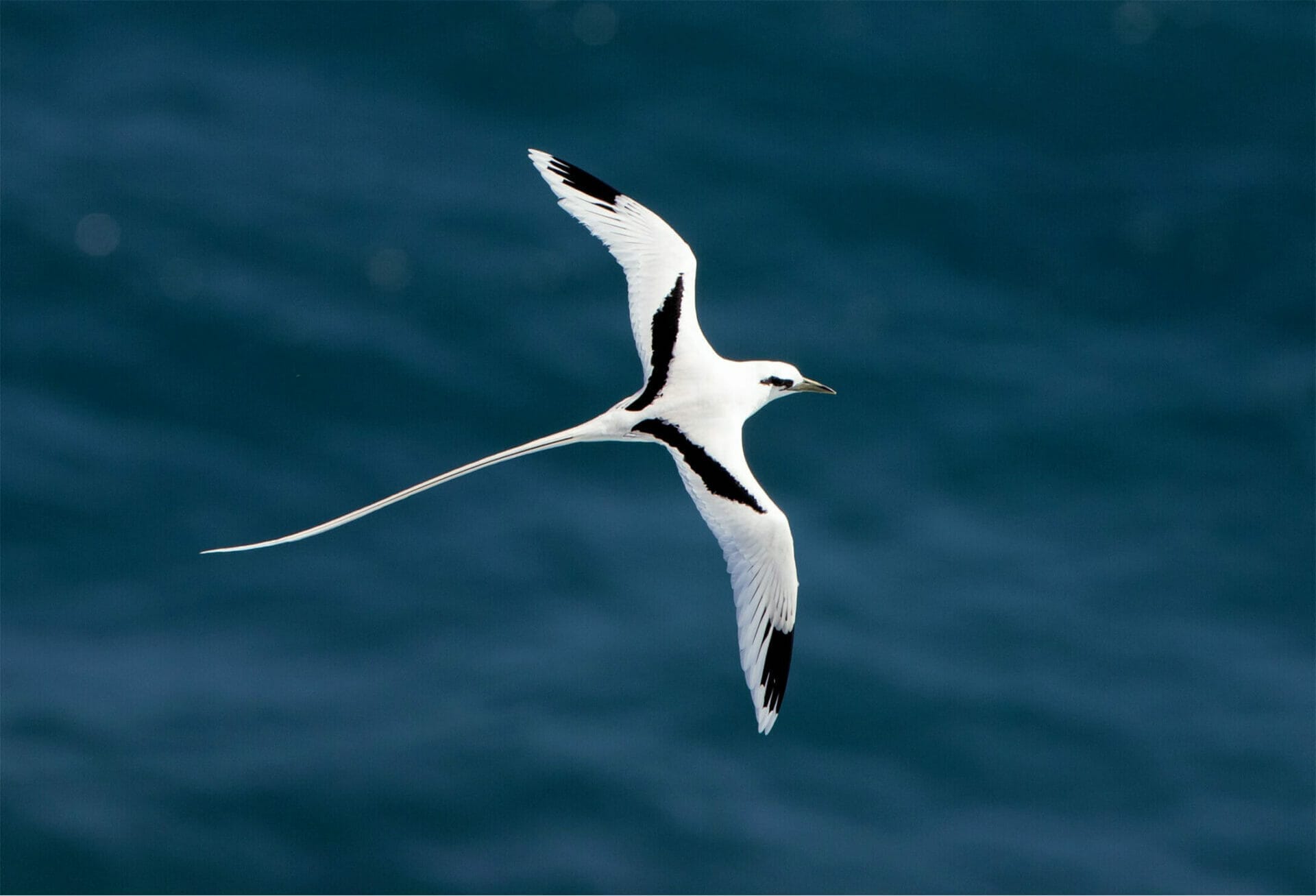
Overall, the White-tailed Tropicbird is an incredible species that thrives in its aquatic habitat, showcasing its unique features and adaptability in the natural world.
| Attribute | Information |
|---|---|
| Common Name | White-tailed Tropicbird |
| Scientific Name | Phaethon lepturus |
| Appearance | Distinctive white plumage, long white tail feathers |
| Wingspan | Approximately 36 to 39 inches |
| Length | Up to 30 inches |
| Diet | Fish and squid |
| Feeding Behavior | Uses sharp, hooked beak to catch prey |
| Habitat | Primarily at sea, comes to land for nesting |
| Nesting Location | Remote rocky islands, often in large colonies |
| Incubation Period | Around 40 days |
| Nestling Period | Approximately 70 to 75 days |
| Population Size | Estimated to be relatively stable |
| Threats | Introduced predators (rats, cats) |
| Lifespan | Up to 20 years in the wild |
| Top Speed | Around 40 miles per hour |
| Plumage | Beautiful white plumage covering entire body |
| Adaptability | Thrives in aquatic habitat, showcases unique features |
Semipalmated Plover
The Semipalmated Plover, known by its scientific name Charadrius semipalmatus, is a small shorebird found in coastal areas throughout the Americas. This species has several distinctive features, including its semipalmated feet, meaning it has partially webbed toes. This adaptation allows the Semipalmated Plover to navigate its sandy habitat with ease. This bird has a wingspan of about 16-18 inches and a length of around 6-7 inches. They can weigh approximately 1-2 ounces.
The Semipalmated Plover primarily feeds on insects, worms, and other small invertebrates in the sand and mud. Its diet also includes some plant matter, like seeds and berries. This species is classified as a type of bird known as a wading bird, often found foraging along the shoreline.
The estimated population size of the Semipalmated Plover is around 300,000-400,000 individuals. However, this species is facing significant threats to its population. Habitat loss and degradation due to human development and climate change are some of the biggest threats to the Semipalmated Plover. Additionally, predation by mammals and birds, like gulls and raccoons, can also negatively impact the population.
The Semipalmated Plover is known for its distinctive coloration. It has a gray-brown back, white underparts, and a black breastband. Its legs are yellow, and its bill is black. This coloration helps to camouflage the bird in its sandy habitat, making it harder for predators to spot.
The Semipalmated Plover can be found along the coasts of North and South America, from the Arctic to the southern countries of South America. During the breeding season, these birds nest in the Arctic tundra, often near wetlands or lakeshores. They lay a clutch of four eggs, and both parents take turns incubating the eggs and caring for the chicks. The chicks can leave the nest shortly after hatching but still depend on their parents for food and protection.
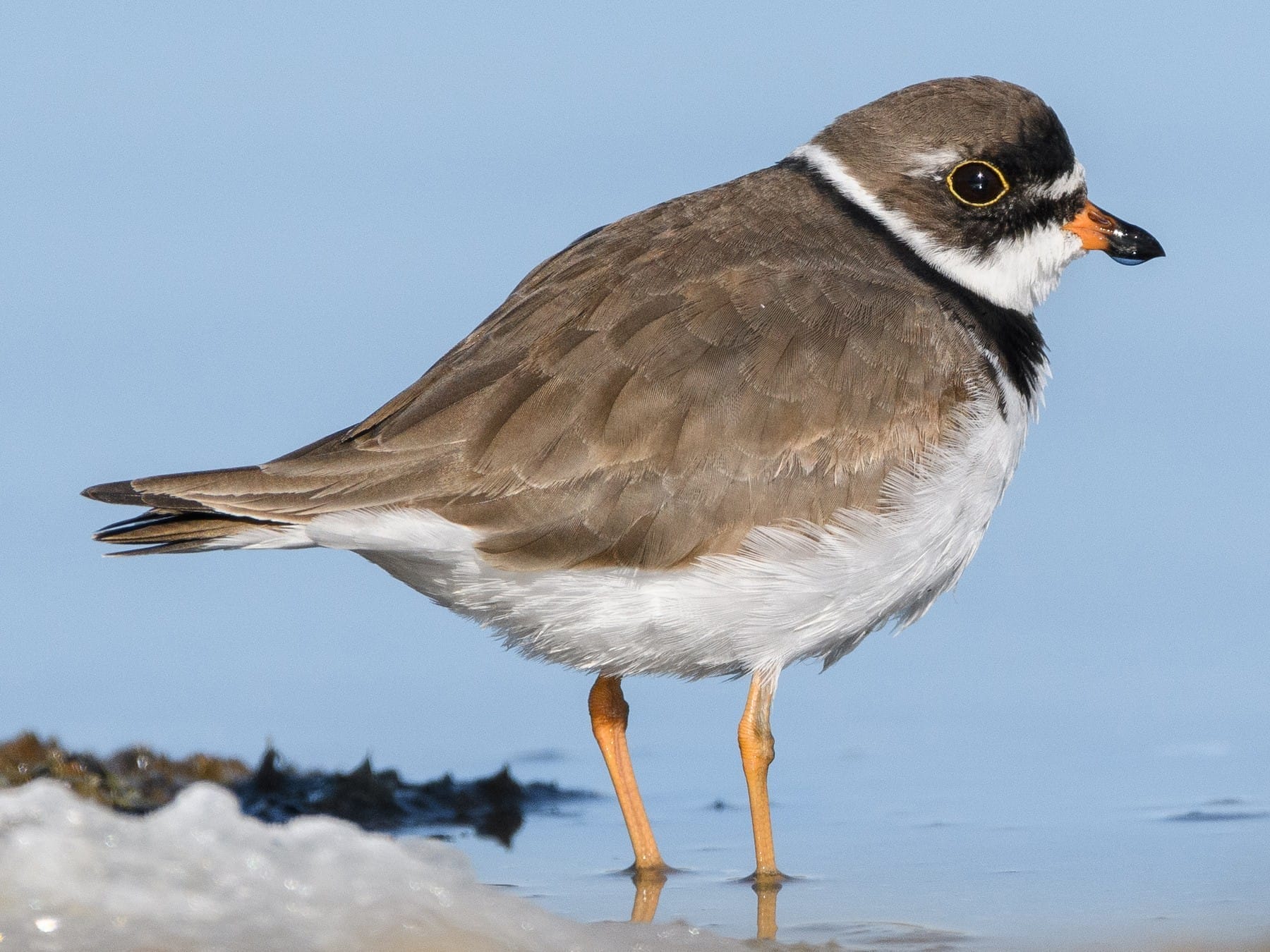
The Semipalmated Plover is a fascinating bird with unique adaptations and a challenging future. Efforts to protect and conserve its habitat are crucial for the survival of this species.
| Property | Description |
|---|---|
| Scientific Name | Charadrius semipalmatus |
| Common Name | Semipalmated Plover |
| Habitat | Coastal areas throughout the Americas |
| Distinctive Features | – Semipalmated feet (partially webbed toes) |
| – Gray-brown back, white underparts, and black breastband | |
| Size | – Wingspan: 16-18 inches |
| – Length: 6-7 inches | |
| Weight | Approximately 1-2 ounces |
| Diet | Insects, worms, other small invertebrates, plant matter (seeds and berries) |
| Type | Wading bird |
| Population Size | Around 300,000-400,000 individuals |
| Threats | – Habitat loss and degradation due to human development and climate change |
| – Predation by mammals and birds (e.g., gulls and raccoons) | |
| Coloration | – Gray-brown back |
| – White underparts | |
| – Black breastband | |
| – Yellow legs | |
| – Black bill | |
| Geographic Range | Coasts of North and South America, from the Arctic to the southern countries of South America |
| Breeding Season | Arctic tundra, near wetlands or lakeshores |
| Nesting Habits | Lay a clutch of four eggs, both parents take turns incubating and caring for the chicks |
| Dependence | Chicks leave the nest shortly after hatching, but rely on parents for food and protection |
Great Egret
The Great Egret, scientifically known as Ardea alba, is a majestic bird that belongs to the heron family. This species primarily preys on fish, amphibians, and small reptiles. One interesting fact about the Great Egret is that it can hunt with incredible patience, utilizing its long, sharp beak to snatch its prey from the water’s surface. Its population size is estimated to be around 125,000 individuals worldwide. The biggest threat to the Great Egret is habitat loss, particularly wetland destruction and degradation.
One of its most distinctive features is its long, slender neck, which allows it to reach deep into the water to catch its prey. Other names, such as the Common Egret and the White Egret, also known as the Great Egret. Its wingspan can reach up to 5.5 feet, making it an impressive sight in flight. During incubation, the Great Egret builds its nest in trees and marshes, and it typically takes around 25 days for the eggs to hatch.
This species predominantly inhabits wetlands, marshes, and estuaries, where it can find suitable feeding grounds. Although the Great Egret faces few natural predators due to its large size, it may occasionally be targeted by larger birds of prey and mammals. Its diet primarily consists of fish but consumes amphibians, reptiles, and sometimes small mammals.
The Great Egret is a large wading bird reaching up to 3.3 feet. With its long, slender body, it can swiftly move through shallow water in search of its prey. The Great Egret has a white plumage that contrasts vividly with its yellow beak and piercing yellow eyes. It has a lifespan of approximately 15 years in the wild and can weigh up to 2.2 pounds.

Overall, the Great Egret is a magnificent bird with remarkable physical adaptations that enable it to thrive in its preferred wetland habitats.
| Attribute | Information |
|---|---|
| Common Name | Great Egret |
| Scientific Name | Ardea alba |
| Family | Heron |
| Prey | Fish, amphibians, small reptiles |
| Hunting Method | Patience and using its long, sharp beak to snatch prey from the water’s surface |
| Population Size | Approximately 125,000 individuals worldwide |
| Main Threats | Habitat loss, particularly wetland destruction and degradation |
| Distinctive Features | Long, slender neck; long, sharp beak; white plumage; yellow beak and eyes |
| Wingspan | Up to 5.5 feet |
| Nesting Behavior | Builds nests in trees and marshes; incubation period of around 25 days |
| Preferred Habitat | Wetlands, marshes, estuaries |
| Predators | Larger birds of prey and mammals |
| Diet | Primarily fish, with occasional consumption of amphibians, reptiles, and small mammals |
| Size | Up to 3.3 feet tall; weighs up to 2.2 pounds |
| Lifespan | Approximately 15 years in the wild |
| Adaptations | Long, slender body for swift movement through shallow water; long neck for reaching deep into the water; white plumage for camouflage; yellow beak and eyes for display |
| Overall Description | The Great Egret is a majestic bird with a white plumage, long neck, and sharp beak. It inhabits wetlands and is known for its hunting patience and impressive flight. |
Monk Parakeet
The Monk Parakeet, scientific name Myiopsitta monachus, is a captivating bird that can be found in various locations around the world. This species has a vibrant green coloration and a distinctive feature: its gray-colored crest on top of its head. Also known as the Quaker Parrot, this species can reach up to 12 inches.
Monk Parakeets have an estimated population size of around several million individuals, and they have been introduced to different countries due to their popularity as pets. They primarily feed on a diet of seeds, fruits, and vegetables. In terms of habitat, they are adaptable and can be found in diverse environments such as woodlands, grasslands, and urban areas.
Despite their adaptability, habitat loss and destruction are among the biggest threats to the Monk Parakeet population. Predators of this species include birds of prey such as hawks and owls. During incubation, the male and female parakeets take turns sitting on the eggs for approximately 24 to 28 days. The Monk Parakeet has a lifespan of around 15 to 20 years and can weigh up to 150 grams. They have a top speed of about 30 miles per hour and molt at around 6 to 8 months of age.
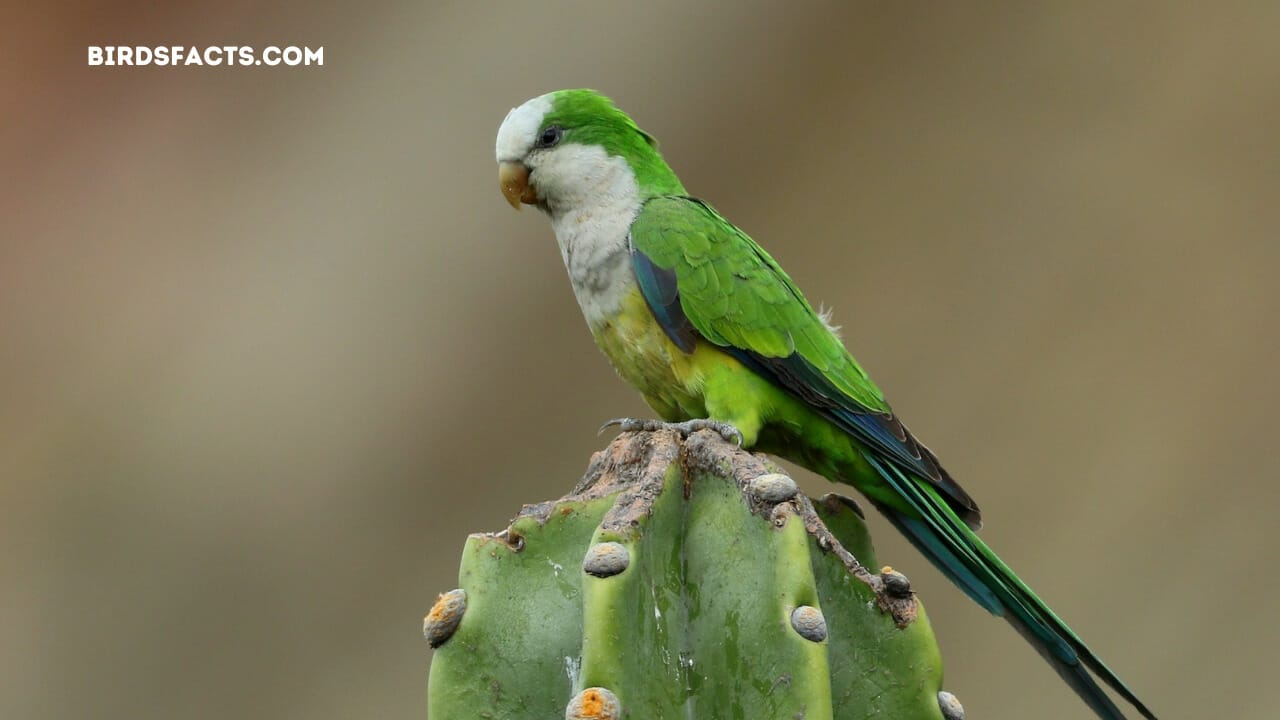
This highly social species often nests in large groups, constructing massive communal nests of twigs and branches. The nests are commonly built on tall structures such as utility poles and trees. The Monk Parakeet’s vibrant green color and distinctive crest make it a fascinating bird to observe in its natural habitat.
| Species Name | Monk Parakeet |
|---|---|
| Scientific Name | Myiopsitta monachus |
| Appearance | Vibrant green coloration, gray-colored crest |
| Size | Up to 12 inches |
| Population Size | Several million individuals estimated |
| Introduced Range | Various countries |
| Diet | Seeds, fruits, vegetables |
| Habitat | Woodlands, grasslands, urban areas |
| Threats | Habitat loss, destruction |
| Predators | Hawks, owls |
| Incubation Period | Approximately 24 to 28 days |
| Lifespan | 15 to 20 years |
| Weight | Up to 150 grams |
| Top Speed | Approximately 30 miles per hour |
| Molting Age | Around 6 to 8 months |
| Nesting Behavior | Highly social, nests in large groups |
| Nest Structure | Communal nests of twigs and branches |
| Nest Locations | Utility poles, trees |
| Interesting Features | Vibrant green color, distinctive crest |
The Amazing Stunning Birds With Orange Beaks
Birds with orange beaks are indeed a sight to behold. The varying shades of orange, ranging from a dull orange to a vibrant golden orange, make these birds stand out. From a distance, thousands of birds with their short orange beaks create a stunning display of color. Some birds have a nib with a black tip, creating a beautiful contrast with the orange plumage.
Others have black plumage on their heads, while their beaks remain a striking orange. These birds are primarily medium-sized, with a black heads and breast that add to their unique appearance. The contrast between the black plumage and the bright orange beak is mesmerizing. Some of these stunning birds have orange rims around their eyes, enhancing their captivating beauty.
The young birds of these species also showcase the beauty of the orange beak. Their beaks have a similar hue to the adults but may appear lighter or reddish. As they grow older, their beaks gradually develop into their species’ distinct, vibrant orange characteristic. These birds with white faces and bright orange beaks are a spectacle to behold in the wild.
These birds with orange beaks are visually stunning and have remarkable features. Their thick orange beaks are specially adapted for their feeding habits, allowing them to grasp and manipulate their food efficiently. These birds are easily noticed with their striking beaks and bright orange plumage. They add a splash of color to their surroundings and have become symbols of beauty and grace in the avian world.
Overall, birds with orange beaks are amazing creatures that captivate the eyes and hearts of all who can witness their extraordinary beauty.
FAQ
What type of birds have orange beaks??
Several types of birds have striking orange beaks. These birds can be found in various parts of the world, including Australia, New Zealand, and tropical regions. The oystercatcher, for example, is a large shorebird with an orange bill and legs. Some birds, such as the black and white oystercatcher, have black beaks with orange skin around their eyes. Other birds with bright orange beaks include red birds with vibrant plumage, an orange beak, and birds with an orange bill and black or black and white plumage. These birds are known to be omnivorous, feeding on various foods.
What is a black feathered bird with an orange beak??
A black feathered bird with an orange beak is an intriguing combination of colors. Its beak stands out with its vibrant orange hue, contrasting with the black feathers on its head and body. This bird is often called the state bird due to its distinctive appearance. The large orange beak, accompanied by orange cheeks and orange skin around the eyes, gives the bird a unique charm. Found in parts of Central and South America, these orange-beaked birds are more significant than many other birds in the region. They are often observed mingling with smaller birds, adding a pop of color to the diverse avian population of South America.
What is a large bird with a long orange beak??
What is a large bird with a long orange beak? In North America, the American Goldfinch is a species of bird that can be found. These social birds are not only beautiful, but they also have distinctive orange beaks and legs. With black and white plumage on their head and breast, they are gorgeous birds with orange beaks. These black birds with orange beaks can be found in North and South America.
Further Reading
You may also check out:
- Black Birds In Florida
- Bird with Red Beak
- bird with orange chest
- Owls In Arizona
- Zenon Unlock Tool 2.2
Thank you for reading!





